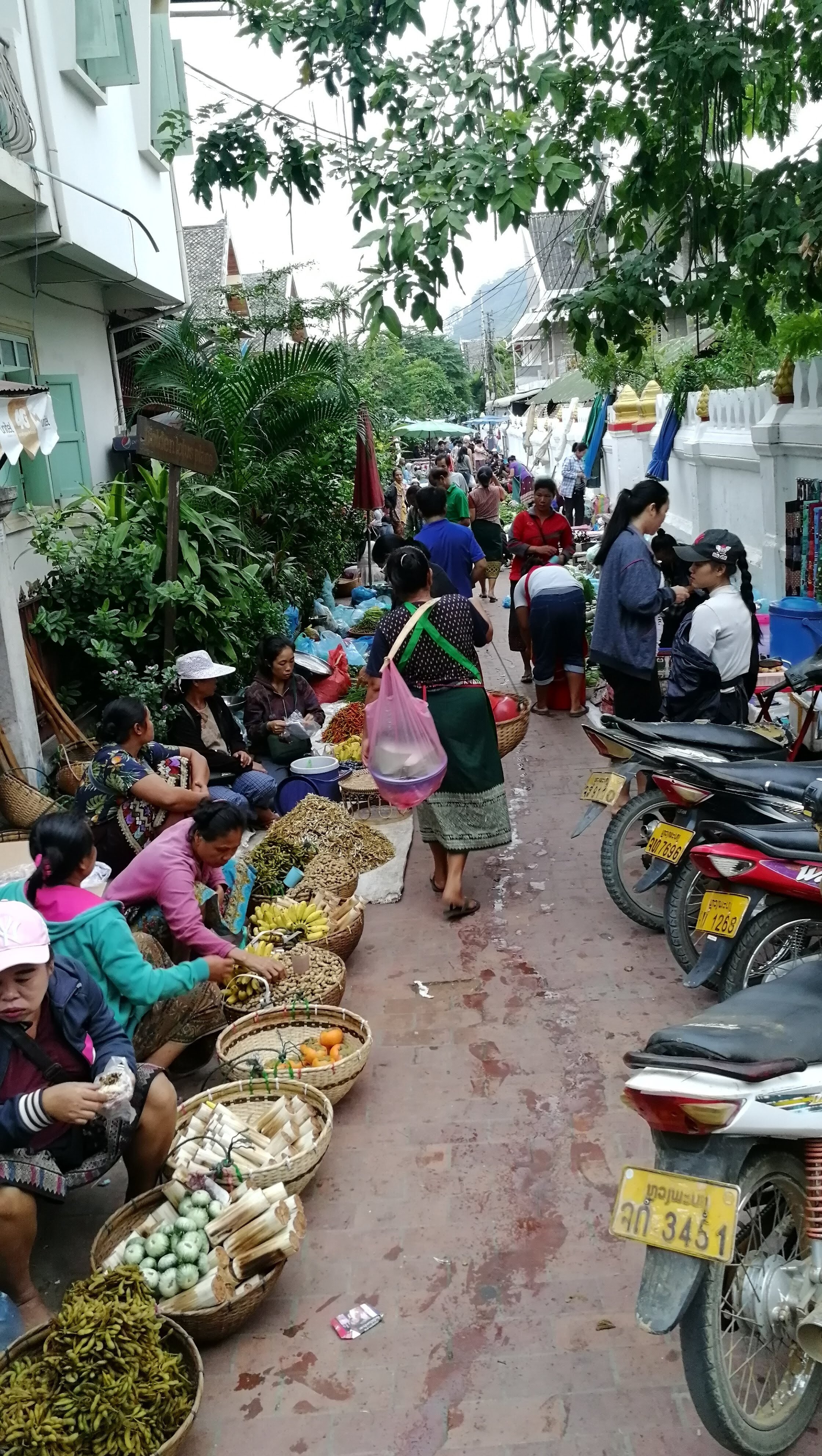
Blog
The Laos Buffalo Dairy Story Part 3 - Breeding Buffalo & Cute Calves
This week’s blog post is a continuation of chef Rachel sharing our story as we tell it on the farm tour. For part 1 click here. For part 2 click here.
This week’s blog post is a continuation of chef Rachel sharing our story as we tell it on the farm tour. For part 1 click here. For part 2 click here.
How we care for Pregnant Buffalo
The first pregnant buffalo arrived at the dairy, and from that moment on, we put into action a system we still use today to look after them. It begins in the fields where we check the buffalo to see if they are pregnant. When we find some that are around eight months pregnant, we arrange for them to come to the farm. If they are within 5km, they walk here, if they are further away than that, but not more than two hours away, we go and pick them up. When they arrive at the farm, we put them in quarantine for one month. During this month, we test them for diseases – Tuberculosis (TB), Brucellosis, Hemorrhagic Septicemia (HS) Water & HSOil – and then we vaccinate for Foot & Mouth and the HS diseases. Unfortunately, there are no vaccines available here in Laos for TB or Brucellosis. If we find a buffalo with brucellosis, we will not take her as it is highly contagious (for buffalo and humans) and causes miscarriages. TB, while it doesn’t affect the buffalo, does pass to humans. Luckily, we have not found any with either of these diseases in buffalo brought here!
Each day, we bring the buffalo into a crush where they are fed, bathed and get their teats played with. Remember, these are essentially wild animals, never managed in the way we handle them, so they need to learn a healthy respect for us as well as each other, so no one gets hurt. It takes about three days for the buffalo to get used to this process, after which we can open the gates, and they will willingly walk in with no issues. The reason for this? They are fed a wholesome diet brought directly to them, and buffalo love food. So, what better way to get it, then to have it brought to you!
After the first month in quarantine, we move the buffalo to the sheds where they spend the next month getting fat and healthy because a healthy mum generally means a healthy calf. She will spend the next month here, relaxing and eating well. When a female buffalo starts to show signs of labour – we’ve had some labours last up to three weeks – we move her into our maternity section so we can keep an eye on her. For the most part, we don’t need to step in and help, but occasionally, we are needed. In the last few years, we have had less than a handful of times where we have required our team members to help a calf be born. Had they not been on our farm, those calves would undoubtedly have died, and the chances are good that the mum would have as well.
Once her calf is born, mum and the calf are kept together for the first three weeks so that the calf receives the best possible start to life. This practice is very unusual, in most of the dairy sector, a mum and her calf are almost always separated at birth and not reunited. But for us, that isn’t an option. As we don’t own these animals, we need to make sure that the female buffalo and her calf develop a close bond, so that when they go back to the farmer, the calf doesn’t get lost in the fields. For a farmer to have a calf wander off, would be like having the interest on your bank account wandering off!
A mum and baby relaxing together in the sheds.
After the first three weeks, we only separate the mum and calf at night. Mum comes in first thing in the morning and is milked and then we put her back with her calf for the rest of the day so the calf can continue to bond and also have mum’s milk. We found that this method is healthier for both the female buffalo and her calf. The calves quickly get used to this routine. If you happen to be on the dairy site in the evening, you can see the calves walking away from mum and going to put themselves to bed in the night time pen. They get so used to the routine that we can even leave the gates open, and they won’t go anywhere until morning. That is of course, except for the very cheeky calves, who are likely to sneak off at night for a warm drink. ☺
Morning milking sessions.
When we start milking the female buffalo, then we start paying the farmer a rental fee. But how much the farmer receives depends on his buffalo. The buffalo provide milk for approximately six months. If the buffalo is a good milker, then we can milk her longer and pay more, but if she is not a good milker, we can milk less and pay less.
Feeding the buffalo on the mini farm before she goes home to her farmer.
After six months of milking, we move the mother from the dairy side of the farm to the tourist mini-farm. Here, the buffalo is the star attraction in the milking demonstration, while we dry her off. Your average dairy cow gives you between 30 and 70 liters of milk a day, but buffalo provide much less. Our local Swamp buffalo only provide about 2.5 liters a day, so when they get to the mini-farm for drying off, they only give a few hundred grams of milk a day. This is why buffalo products cost so much more than cow’s milk product. After their time on the mini-farm, we return them to the farmer. We aim to return all the buffalo when they are between 3-4 months pregnant, and with better genetics on board.
Ferdinand, our friendly Murrah buffalo, posing for the camera.
How we stumbled into setting up a Breeding Program
In 2016 when we were first setting up the farm, we were looking to own the buffalo. However, while calling and emailing around to look for buffalo to buy, we stumbled across the GuangSi Institute in China. When we asked them if we could purchase buffalo from them, they promptly told us no because they only sell to public and government entities, and we were neither. We thanked them and went on our merry way. But then, they emailed us back and asked where we were. When we told them, in Laos, they immediately thought we were affiliated with the breeding program that they had helped set up with the Laos government. They started to include us in all their correspondence back and forth with the Laos government, and we were able to see what was going on with the program.
In June of 2016, we were invited to a meeting in Vientiane, between the Chinese and Laos governments, to ask what it was we were doing. To make a long story short, we told them that we were in the process of building a farm to house 200 buffalo at a time, 400 over a year. We knew that over the last 30 years the buffalo numbers and size in Laos had been decreasing and the genetics were changing, due to a lot of inbreeding practices, lack of vaccinations and not having the proper feed. We explained that we wanted to rent the buffalo from the farmers to milk them, and in the process crossbreed them with the Murrah buffalo that the Chinese government had brought in, to make bigger, stronger, healthier buffalo, and make them better milkers as well. Murrah buffalo can give between 8-10 liters of milk a day, so that was perfect for us.
After our explanation, it was decided that the two Murrah buffalo at the agricultural center in Vientiane should be moved to our farm, along with the whole breeding program! And so, our breeding program began.
First Murrahs on the farm - April 2017
One day, two bulls, some semen and equipment for doing the insemination process arrived at the farm and then, all we needed was training! Enter our two international vets! Dr. Ohm, is a world-renowned specialist in buffalo reproductive health and Ronald van Giessen, is a specialist in artificial semination and a specialist in Developing Nations Agricultural Projects. They each played an essential role in training our team to be able to do artificial insemination and get the breeding program up and running.
With everything in place, In December of 2016, we went to Thinkeo Village, next door to the farm, and instigated an artificial insemination program there for the buffalo. We didn’t think anything would come of it because we didn’t think the semen was viable. Still, for training purposes, it was fine. But then, shocker of all shockers, in October 2017, we got a call from Somlit, our favorite village chief at Thinkeo Village, and he told us that his buffalo had just had a baby and it was a crossbred calf. We told him we didn’t think that could be possible, but he insisted that she was, and he wanted us to bring her to the farm so we could show the other farmers that what we were doing was good for everyone. Of course, we agreed, and he brought her to the farm.
The other farmers didn’t think that you could breed a Murrah and a Swamp; they just didn’t think it was possible. Even when we had explained that we weren’t doing anything new, we were just bringing the technology and process here to Laos, and farmers had already done this in other countries, they didn’t want to believe it. So, for us, Somlit’s buffalo would be a light in the window, if she was indeed a crossbreed.
We love Somlit so much – he has always been wonderful to us. Whenever we have a crazy idea that we want to try out, we turn to Somlit and say, “What do you think about….?” He always hums and haws for a minute or two, and then says, “We’ll make it happen.” He’s a very outside the box kind of guy who is always willing to try something new.
Sophia in December 2017 after being on the farm for a month.
Oh, the lovely Sophia!
At the beginning of November, Sophia and her mum walked down the road to the farm; we confirmed that she was a crossbred calf and much rejoicing followed! Sophia and her mum stayed in quarantine for our requisite one month stay. We vaccinated mum, and before long, she and Sophia were moved to the mini-farm to greet farmers and guests. Having Sophia there allowed us to show farmers the difference between Sophia’s size and that of a local Swamp buffalo of the same age. Sophia was obviously both taller and broader. She also loved attention, and a star was born ;0).
Longer-term, it would be the responsibility of the two bulls – Ferdinand and Fabio – to maintain the breeding program. In our first year, Sophia was the only crossbred calf, but with the use of artificial insemination, we were expecting about seven more in Year 2.
Installing Laos’ first Milking Machines
So, up until about two and a half years ago, we were the only dairy in Laos. And, as you can imagine, being the first, we had to import all of our equipment from outside the country. We are still the only buffalo dairy here in Laos, but there is now at least one cow dairy in Vientiane, and we’ve heard talk about the building of another cow dairy in southern Laos.
We brought in a proper machine set up to milk 16 buffalo at a time. That is enough to milk 200 buffalo a day and 400 buffalo a year. When we get to the point that we are milking 400 buffalo over a year, the rental fees that we pay back to the farmers will amount to approximately $40,000 USD a year. All of that money goes directly into a farmer’s pockets, and it is money that they would have otherwise not gotten for their “buffalo bank account”.
Buffalo entering the waiting area for milking.
Buffalo Farm or Buffalo Spa!
In front of the milking area, is the waiting area for the buffalo. With about 60 buffalo on the farm at the moment, the buffalo come in in smaller groups and wait in the waiting area. We milk four or five buffalo at a time. While we milk them, we also feed them. After milking and feeding, they move into the “exit” room and receive a shower. Buffalo come in first thing in the morning and have a shower, in the evening they come in again for another shower and then in the middle of the day they come in for a shower and a scrub down. Once a month they get their nails done. Yep, this farm sounds more like a buffalo spa!
After the showers, the buffalo wander back to the sheds. We currently have three sheds, which provides capacity for 150 milking buffalo at a time. In the back corner is the quarantine shed. We recently expanded our quarantine, so we can now bring in about 40 buffalo at a time. We were hoping that we were going to be able to get funding this year to build the fourth and final shed so we could house 200 milking buffalo, but with everything that has happened in 2020, that isn’t to be (yet!).
Next time join us for the final part, as we take you on a virtual tour of the mini-farm. Find out who you meet and what you can get up to on a visit to the dairy.
Coming in January….. We did a Pod Cast with Foolish Careers. Keep your eyes on our media for when it goes live. Or sign up on their website at https://foolishcareers.asia for pod casts to land in your mailbox directly!
Haven’t heard of the Foolish Careers podcast before? That’s because it’s brand new! Check out the description from the website to see what constitutes a “foolish career” and why it’s a new thing! https://www.foolishcareers.asia/p/this-is-for-those-of-us-who-ignored
Will you be in Luang Prabang from 23 December - 3 January? Are you looking for something to do?
With more than 60 businesses participating, the LPB community is coming together to create a memorable December Holiday season. Come join us for all sorts of events and fun things. To find out more go http://www.whatsuplao.com/ to see all the happenings and plannings.
HAVE YOU SEEN OUR SOCIAL MEDIA THIS WEEK?
If not, pop on over to facebook/laosbuffalodairy or instagram/laosbuffalodairy to see what we have been up to!
The Laos Buffalo Dairy Story: Part 2 - Building Laos’ first dairy - the first Buffalo arrive
Part 2 Building Laos’ first dairy - the first Buffalo arrive
Three days before our six-week trial was due to end, we managed to bring in a single cow milking machine from China. This machine ran on either electricity or petrol, which is important to note, as Mr. Eh didn’t have electricity near the field at the time. The machine arrived flat packed in the early evening, and Steven and Mr. Thon, our trusty tuk tuk driver, boldly took on the chore of trying to set it up in the failing light. With the instructions translated from Chinese, loosely into English, this was no easy task. Luckily, the instructions also kind of looked like IKEA instructions with lots of pictures to guide them.
This week’s blog post is a continuation of chef Rachel sharing our story as we tell it on the farm tour. For part 1 click here.
Part 2 Building Laos’ first dairy - the first Buffalo arrive
Three days before our six-week trial was due to end, we managed to bring in a single cow milking machine from China. This machine ran on either electricity or petrol, which is important to note, as Mr. Eh didn’t have electricity near the field at the time. The machine arrived flat packed in the early evening, and Steven and Mr. Thon, our trusty tuk tuk driver, boldly took on the chore of trying to set it up in the failing light. With the instructions translated from Chinese, loosely into English, this was no easy task. Luckily, the instructions also kind of looked like IKEA instructions with lots of pictures to guide them.
The following day we were very excited to try the machine to see if we could get more milk than from milking by hand. It felt like the entire village came out to watch! They had been watching over the previous six weeks all the new and unfamiliar things that we, as the crazy falang (the term for all ‘foreigners’) had come up with. As luck would have it, not a drop of milk came out. It turned out that buffalo are very sensitive to change. The machine was noisy and it made them nervous. So, we vowed to try again the next day. Finally, with two days left, we got some milk from the machine milking approach.
Our trial finished just in time for Steven and Susie to go back to Oz for a holiday. And when they came back, it was time to sit down and discuss our next steps. We decided to move ahead with the dairy, and that meant we put the idea of building a hotel on hold!
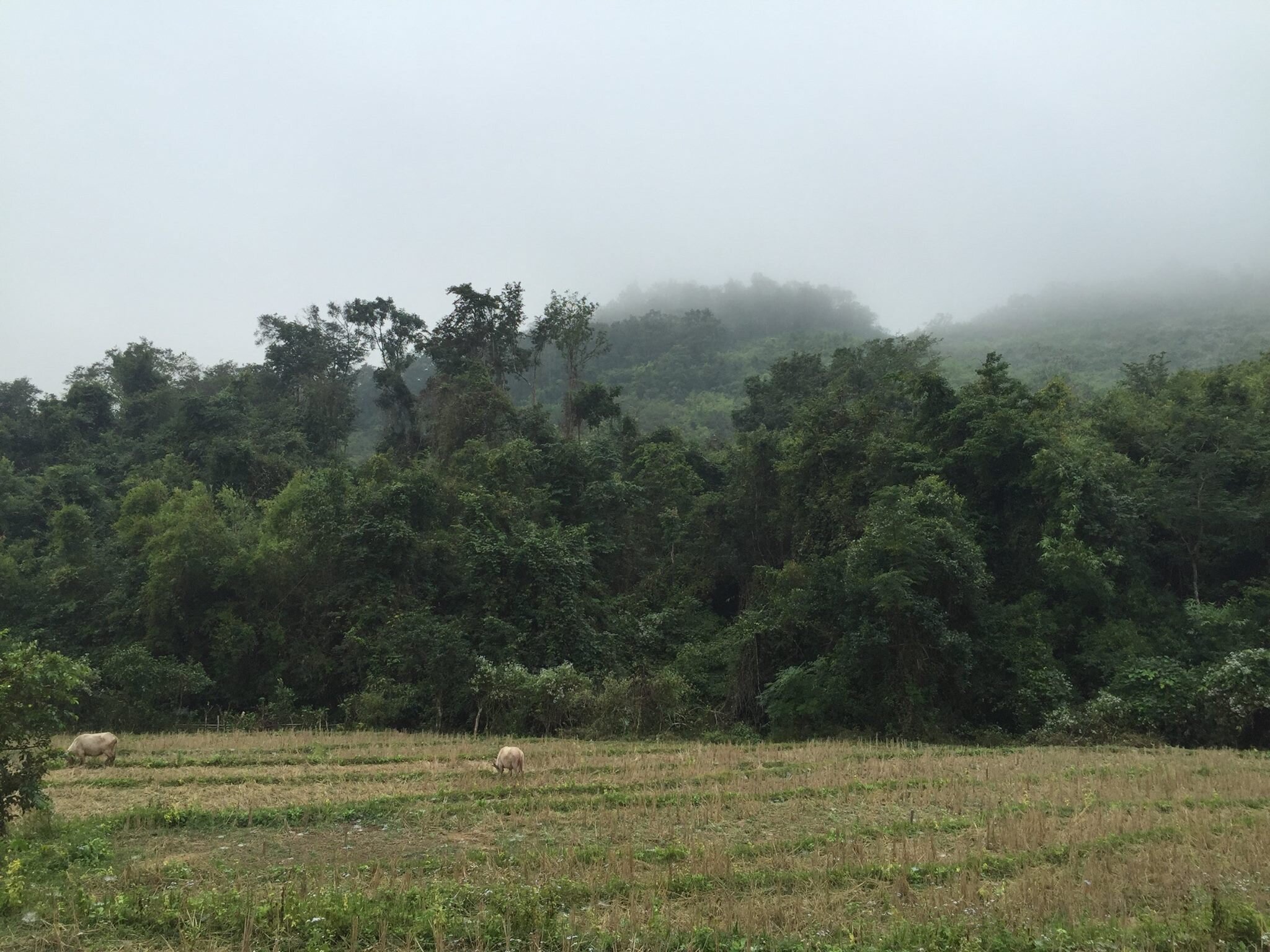
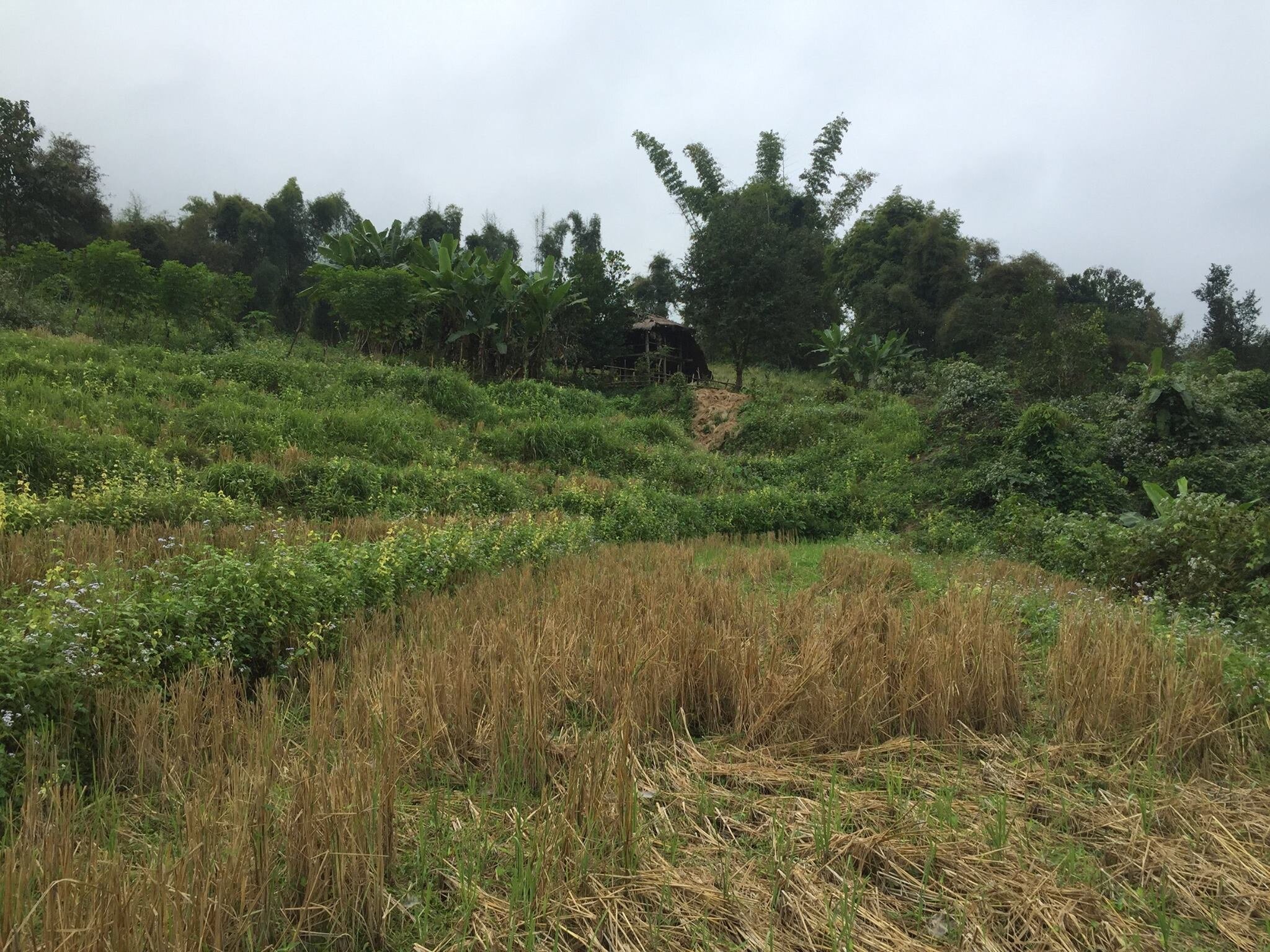
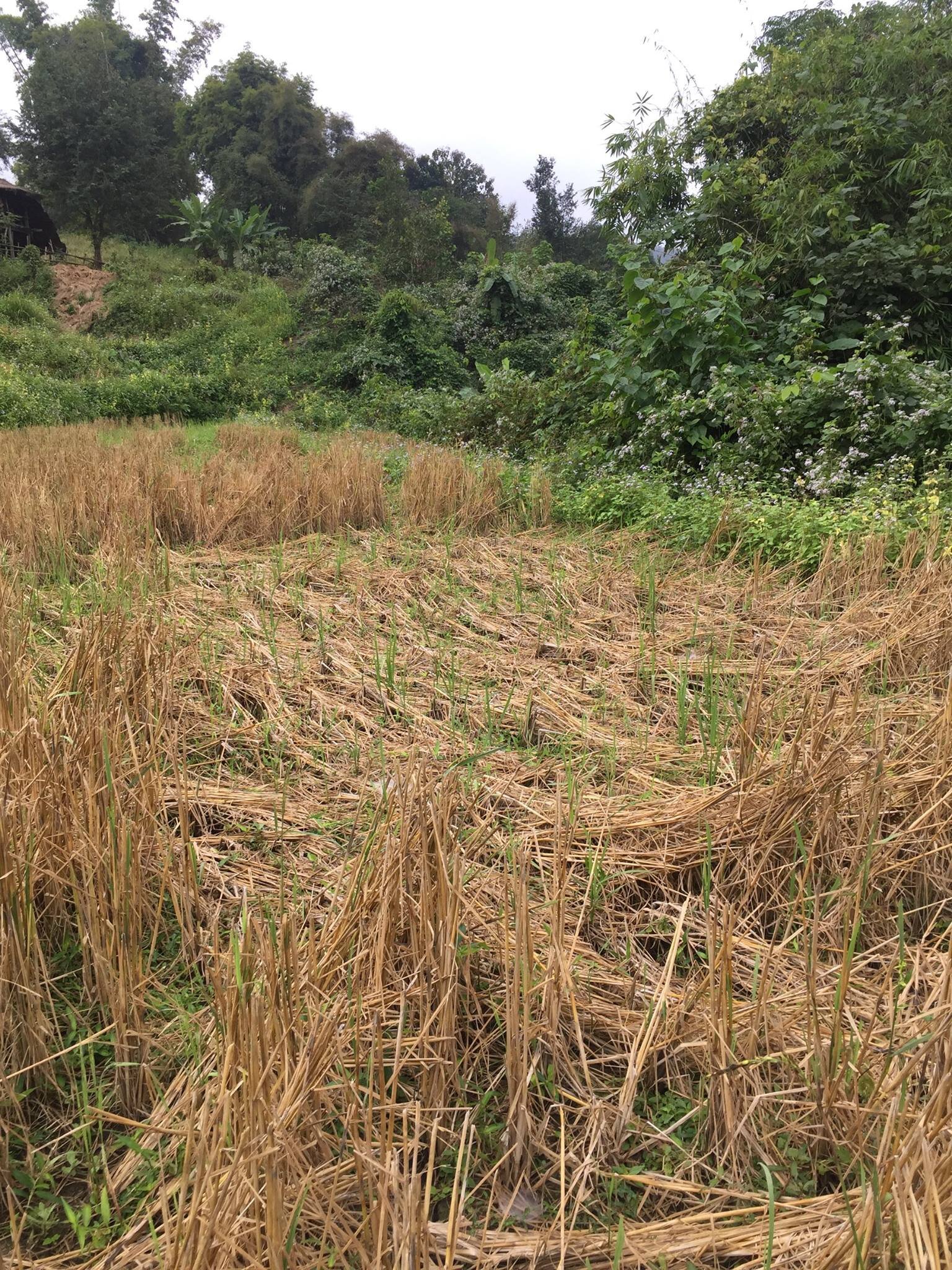
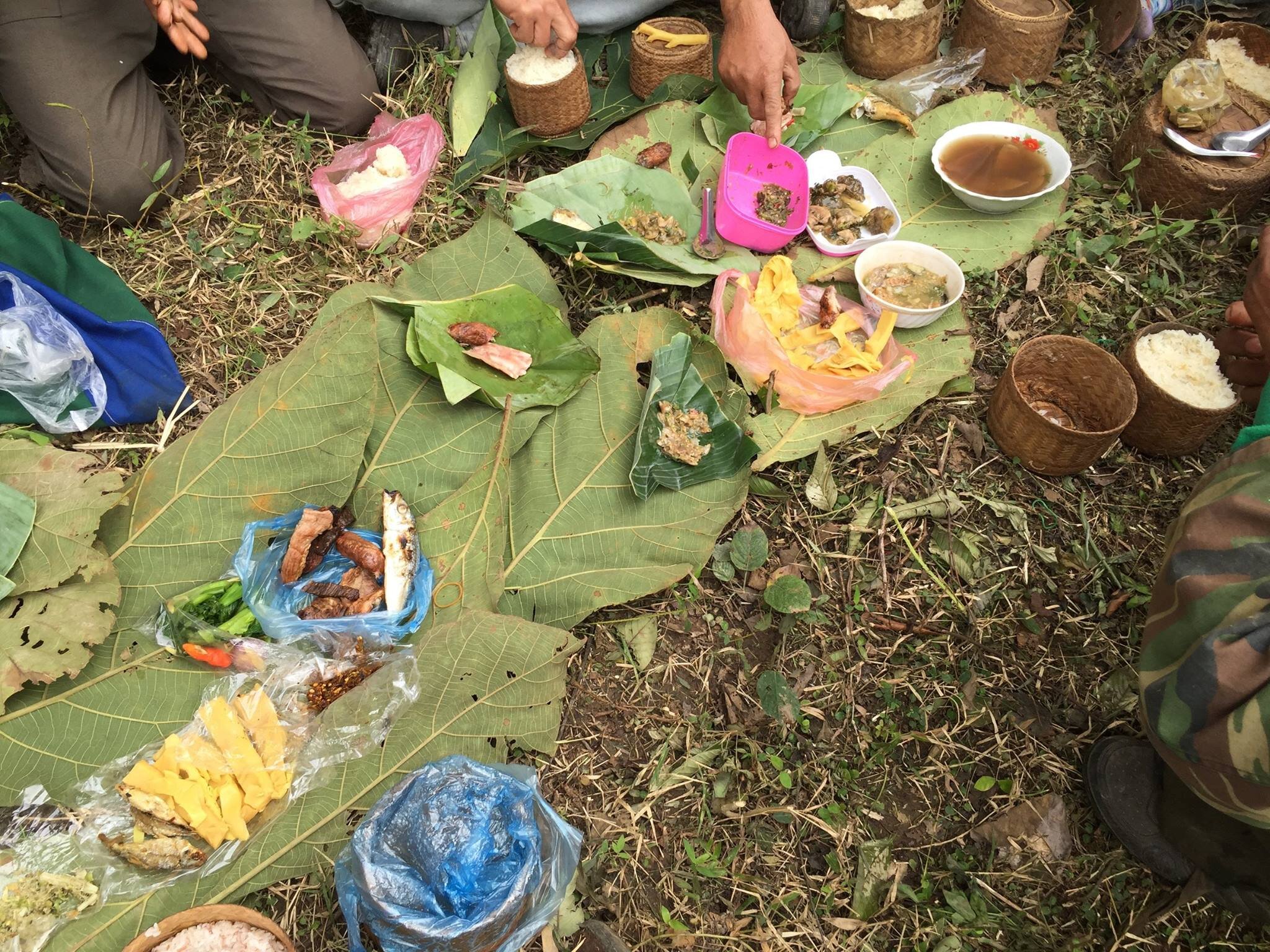
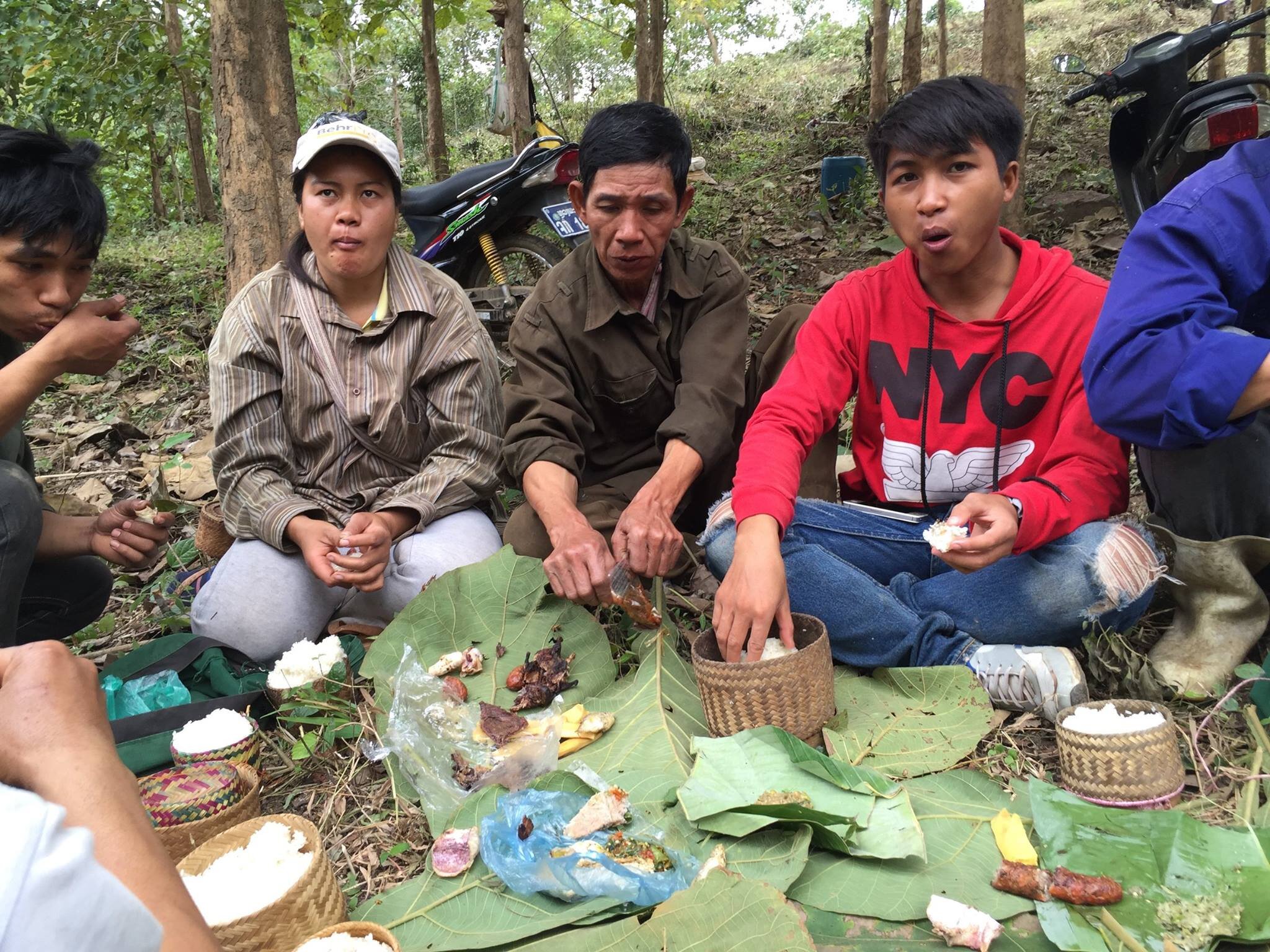
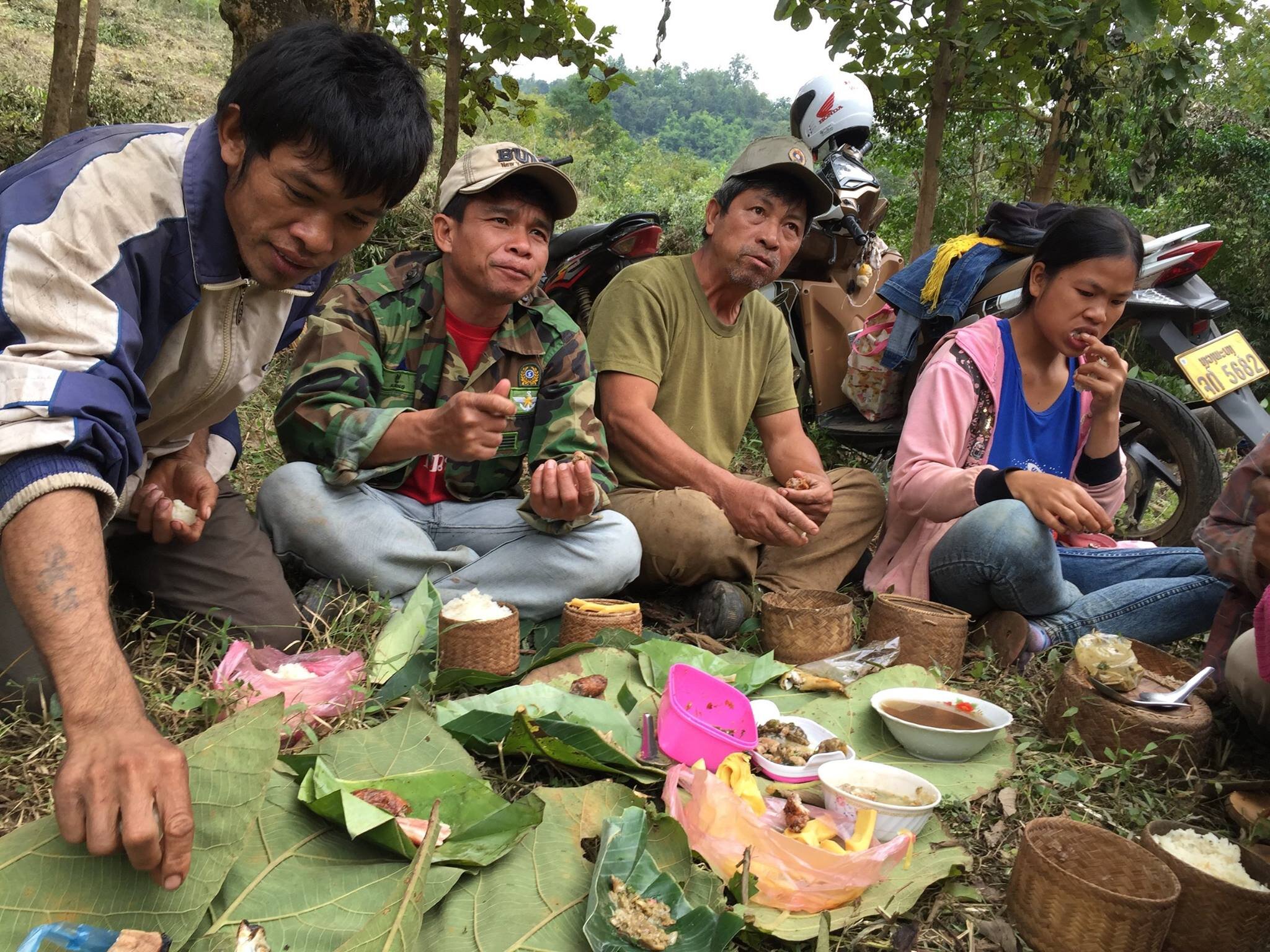
Laying the foundations of the Dairy Farm
To build a dairy we needed land, and so we sent the team out to look for somewhere suitable. They looked and talked with farmers and landholders. We looked at many parcels of land and, finally, after talking with a bunch of farmers in Ban Naxao, we decided that we had found a suitable bunch of connected properties that would work. We rented the land for a two-year period with options to renew, and spent lots of time clearing the land and building fences. We planted grass, as we knew that this was the most critical first step.
However, when we got to the point that we needed to put in a new road to continue building, we ran into a roadblock. Literally. While we had a signed piece of paper from the village chief stating that we could have four-meter-wide road access, it turned out that it was the deputy village chief who signed that and he didn’t have authority to give it to us. That and we would be going through another piece of property that wouldn’t grant us access where the road was easiest for us to build. We tried negotiating, but were constantly told, “No, you only have motorbike access.” “You can buy this one hectare of land for USD $150,000.” “You can move your road over there next to the creek coming down.” None of these were viable options for us, so we decided to stop with the plan for that site and to look elsewhere.
The team went out again to look for new land and came across the parcel of land that we still have now, in Ban Muang Khay. It was flat, check. It was empty, check. It already had electricity, check. It was on the main road with road access, check. It was on the direct route to Kuang Si Waterfall (a major tourist destination) check, check, check! And so, we began negotiations yet again for land rentals and building rights.
It took about six weeks with 40-60 people every day to clear the land of all the trash and black plastic sunk into the ground from the watermelon farm that was on the land years before. Clearance was an arduous task, but a necessary one since there would be living animals that traditionally forage on site, and we needed to make sure it was all gone to keep them healthy and safe.
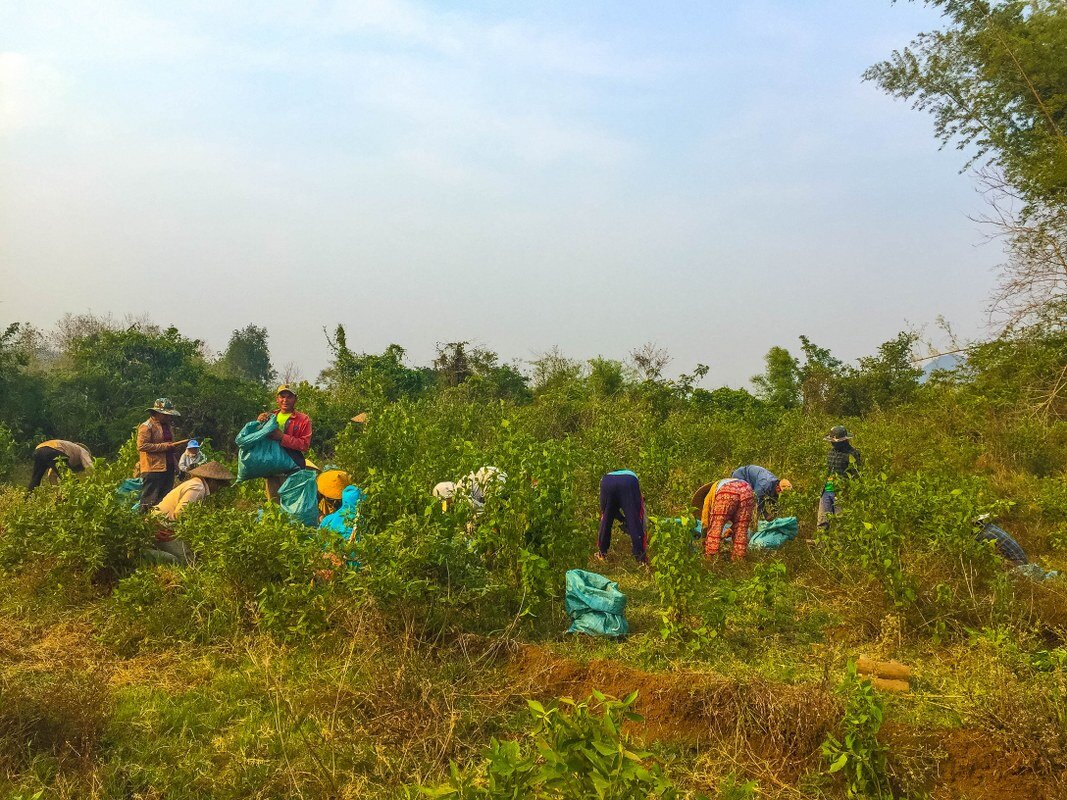
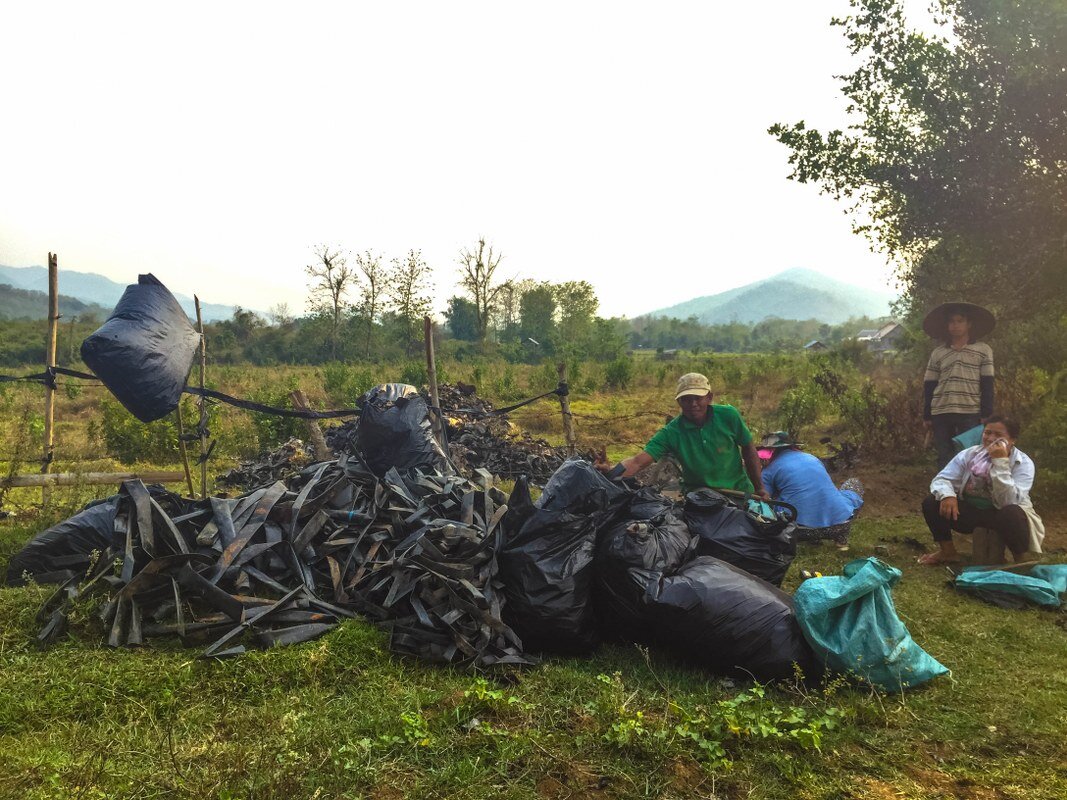
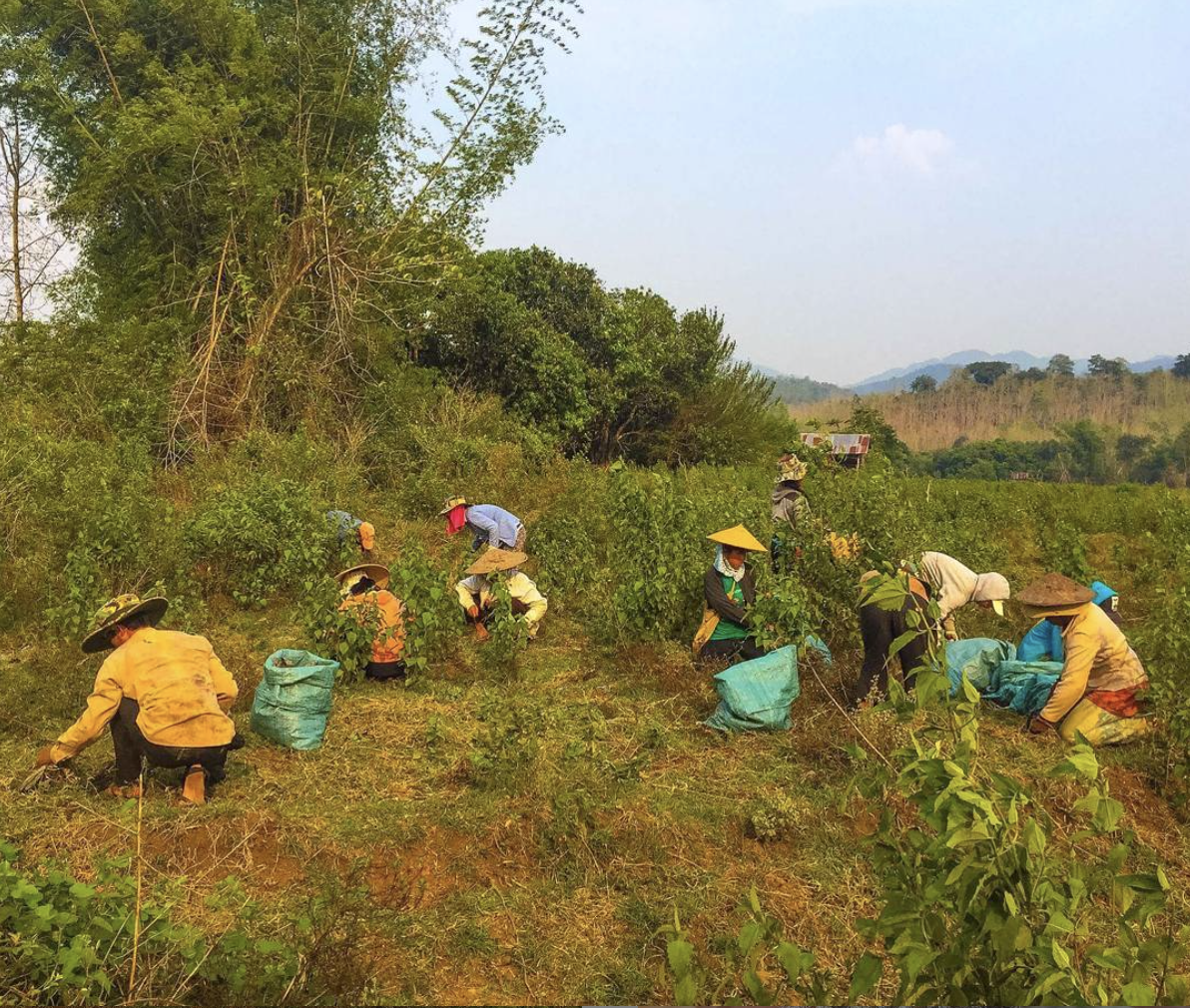
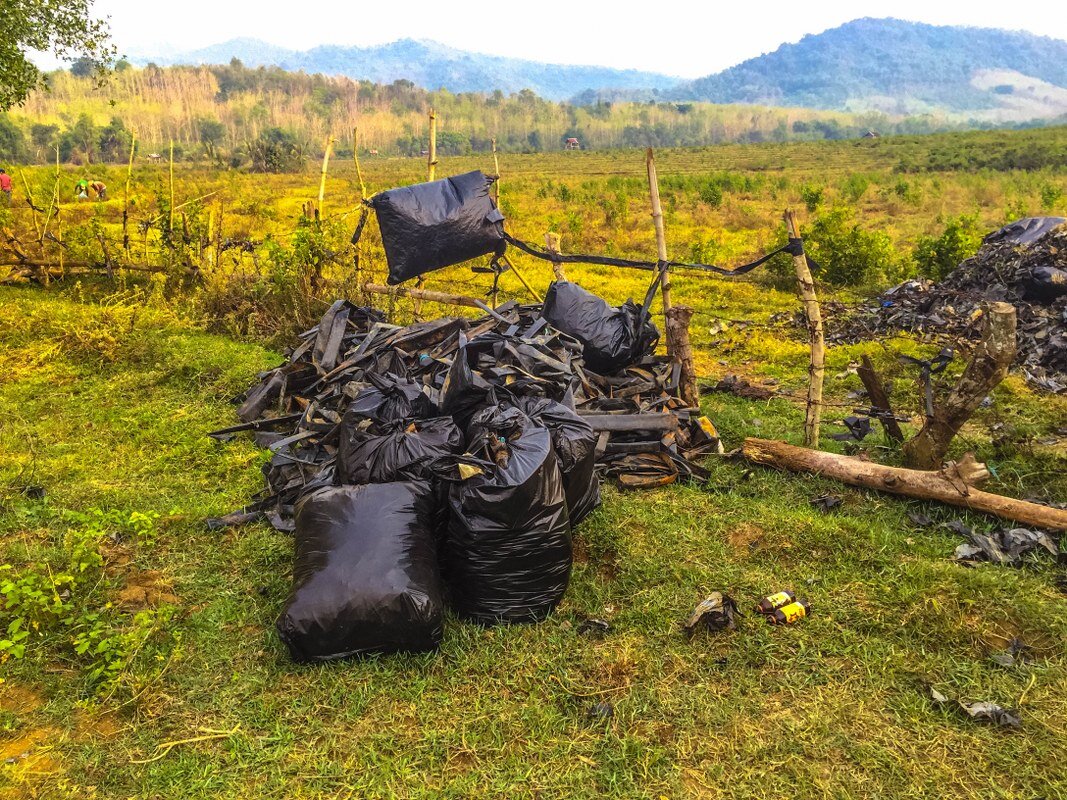
Getting the Farmers onboard
During this time, we prepared and thought about how we could convince the farmers to trust us. We knew that they wouldn’t just give us their “bank accounts”, which is essentially what a buffalo amounts to for a farmer. Farmers keep between three and five buffalo in their “herd”. When they need money to, for example, send a child to school, for a marriage, for a hospital stay, a baci ceremony (a buddhist blessing ceremony), or when someone dies, they sell as many buffalo as they need to pay for whatever it is. But, unfortunately, while the buffalo is their bank account, they don’t make any interest off it. And since they generally cannot afford to pay for vaccinations, there is no guarantee that their “bank account” will provide them with any money since the animal may end up dying of a disease. It’s like a lottery that way.
We decided to hold four informational sessions in one day, spread out over several villages – Kok Mon, Pit Nyai, Ban Jok and Ban Naxao, to talk to the farmers about our idea. Luckily, due to Susie’s persistence with the government, we had Doctor Som, and some other key agricultural officials, on our side to help with these meetings. Dr. Som is a Laos veterinarian who was trained in Cuba many years ago and had an understanding of dairies from his time abroad.
We had our team once again going to villages where there are lots of buffalo, and that are close enough to where the farm would be, to put up fliers about what we wanted to do. While they were in these villages, our team did some preliminary talking with people; asking how many buffalo they had, and would they be interested in coming for an informational session, giving them a brief intro to what we are planning.
We went to these informational meetings with our government allies and had some pretty good turnouts. It appeared more people were interested than not. And they had questions; questions about diseases and the health of buffalo; questions about diets. We answered all of the questions they had. We asked them all to sign an attendance sheet with their phone numbers and planned to have them all visit the farm soon.
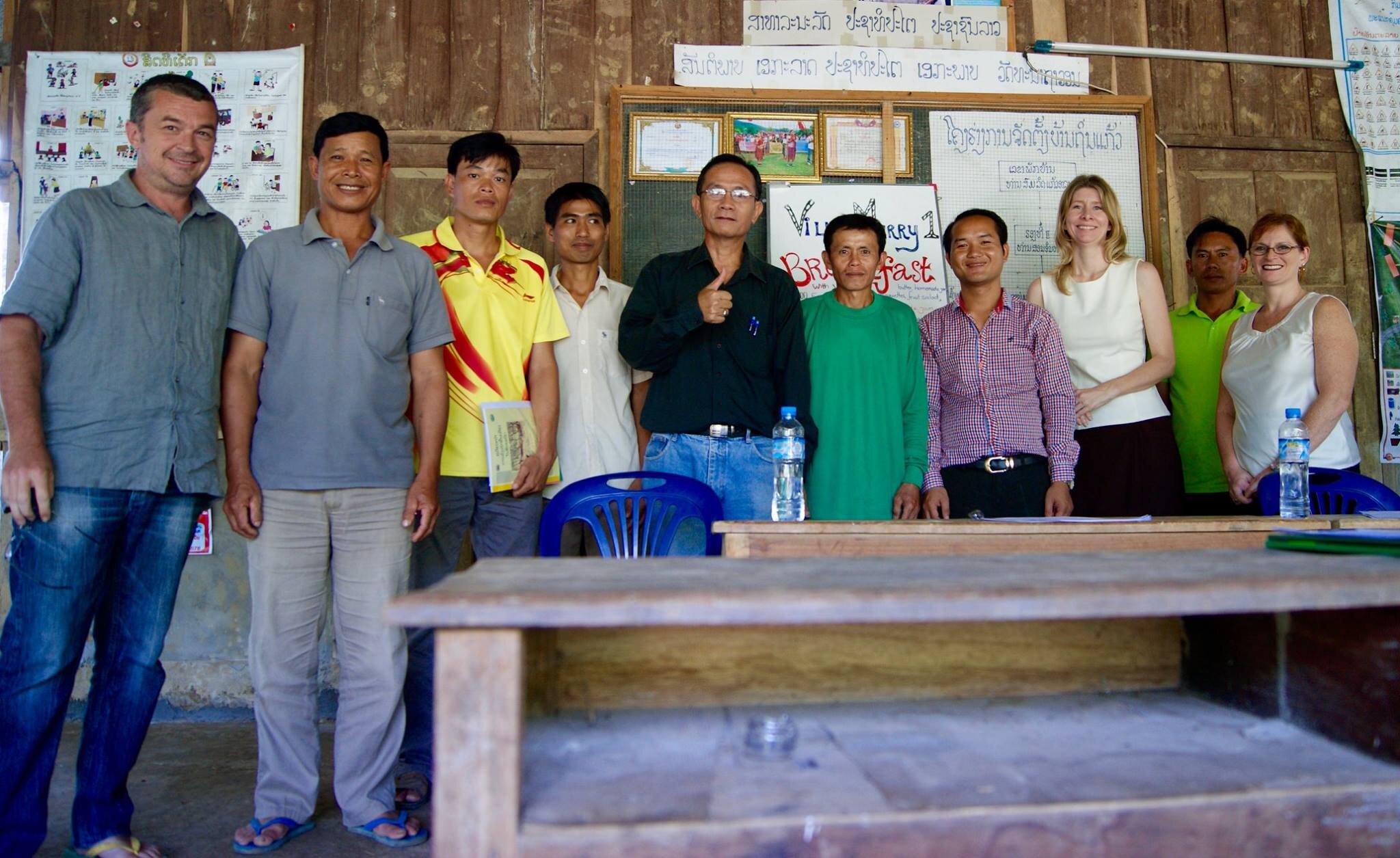
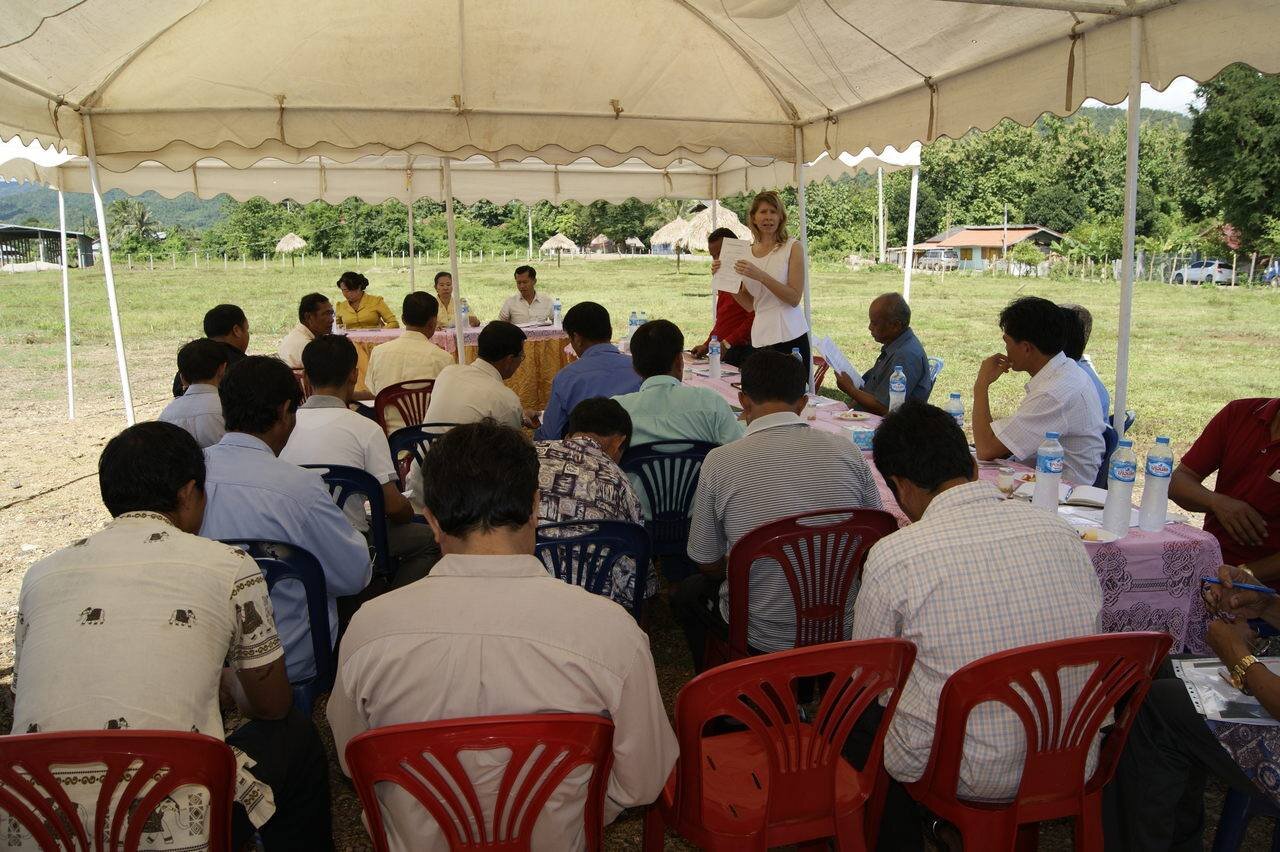
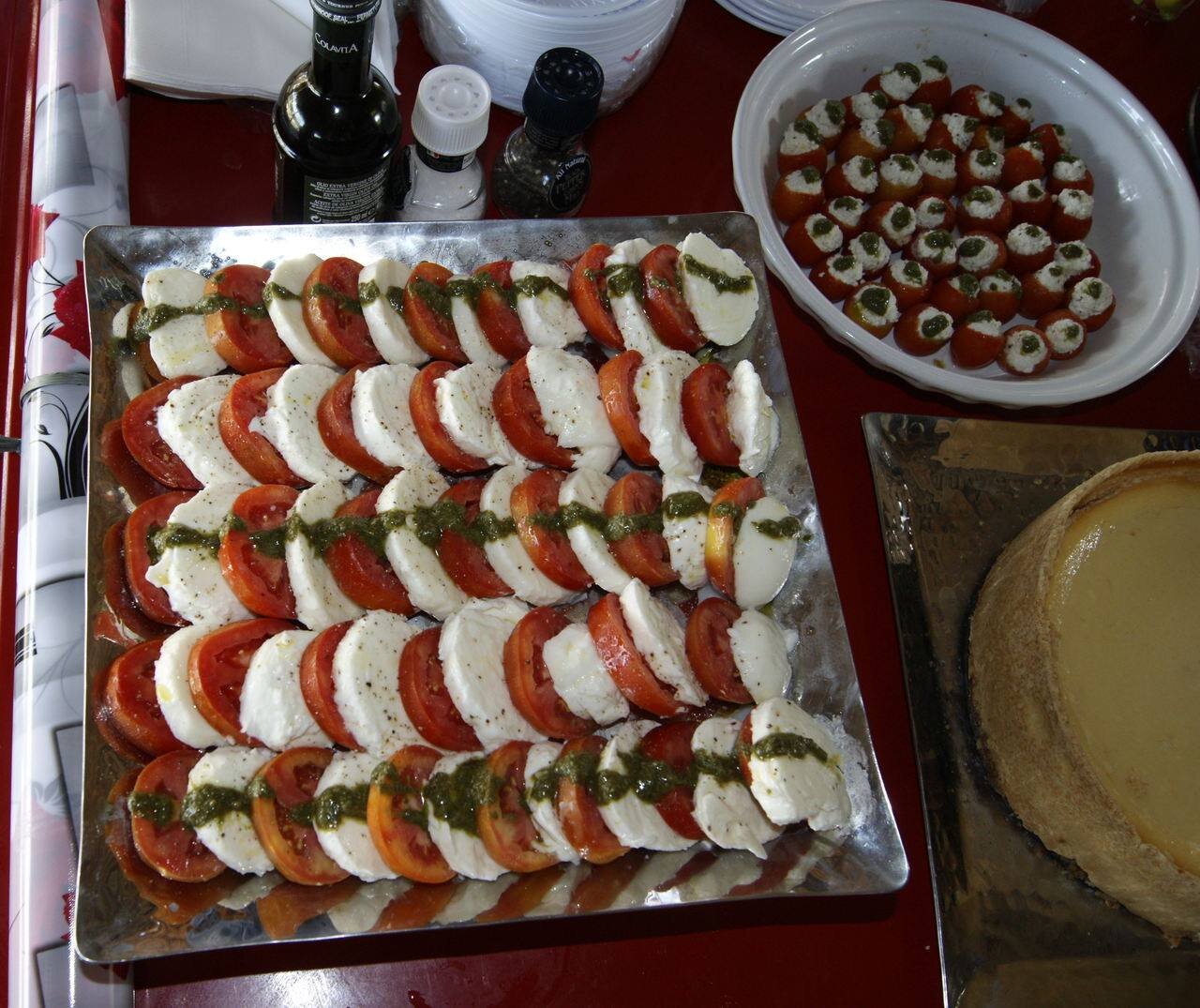
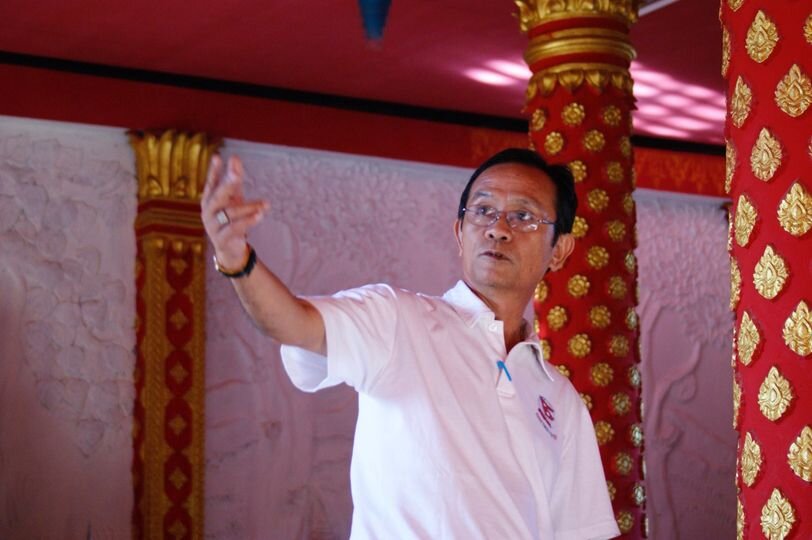
Talking with the Village Chiefs
For the next stage we brought the village chiefs to the farm and showed them what we were doing. We needed to get the village chiefs on our side before the farmers would agree to work with us. So, we set up a meeting, in October 2016, with 17 village chiefs at the farm and explained our new business and what it would mean for the farmers. We prepared yogurt, mozzarella caprese, ricotta stuffed tomatoes and cheesecake for the chiefs so they could taste what we would produce. We had Doctor Som with us, as well as other agriculture government officials, who helped explain and helped show them around. We talked about writing up a contract that is mutually agreed upon that each farmer would have to sign when they bring us their buffalo. Once all of that was set, our next step was to bring the farmers in.
Farmers Visit the Dairy
We arranged with the villages to come to visit the farm one village at a time, and they brought all the farmers who had buffalo. Every time they came we talked with them about what we were doing and how it would benefit them. Remember Mr. Eh and chief Somlit from earlier? Well they were some of the first people to have buffalo on our farm. This helped when the other farmers came. The farmers could see how the buffalo were handled by us and our team. They could see how healthy they were, and how much better the body condition was than the buffalo that were left to roam around unattended.
The farmers liked what we were doing but they were still skeptical about bringing their animals to us. They wanted to see their brother, cousin, or neighbor do it first to see the results. We understood that, it’s a lot to ask for their trust to do something when they have no idea how it will turn out. It’s like telling someone, give me your bank account and I promise I’ll return it in full with interest. Why would you trust that someone would do that? So, we needed to prove to them that it would be worthwhile.
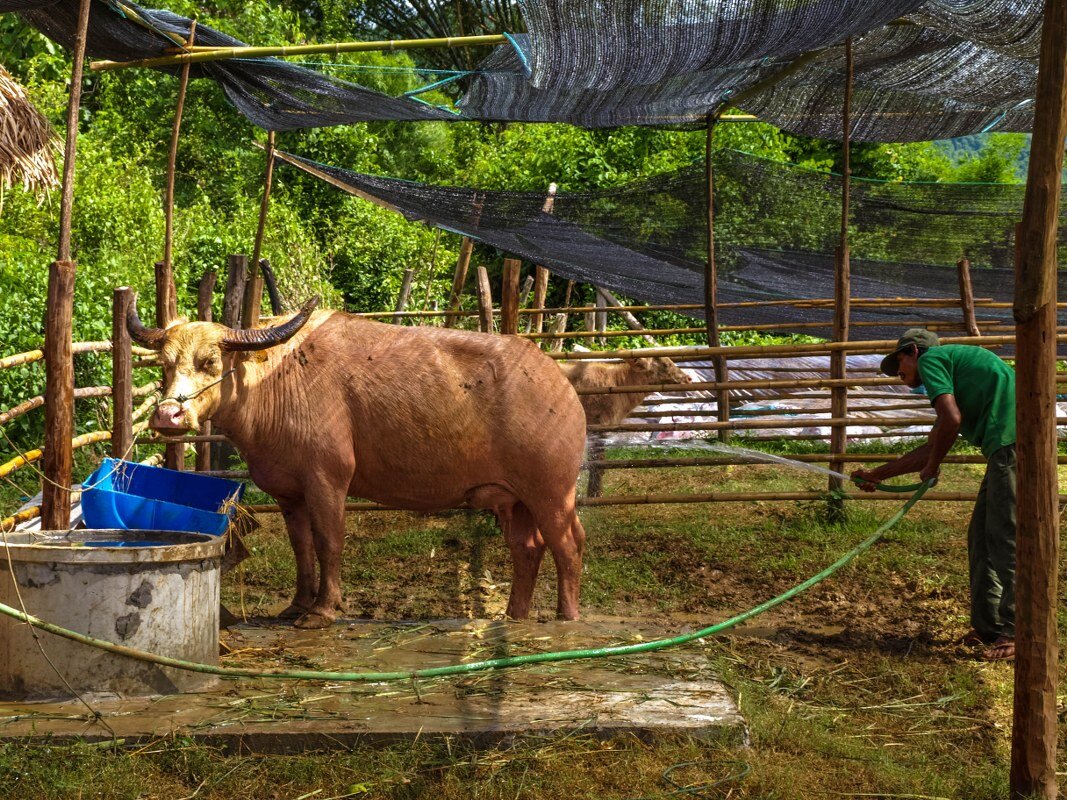
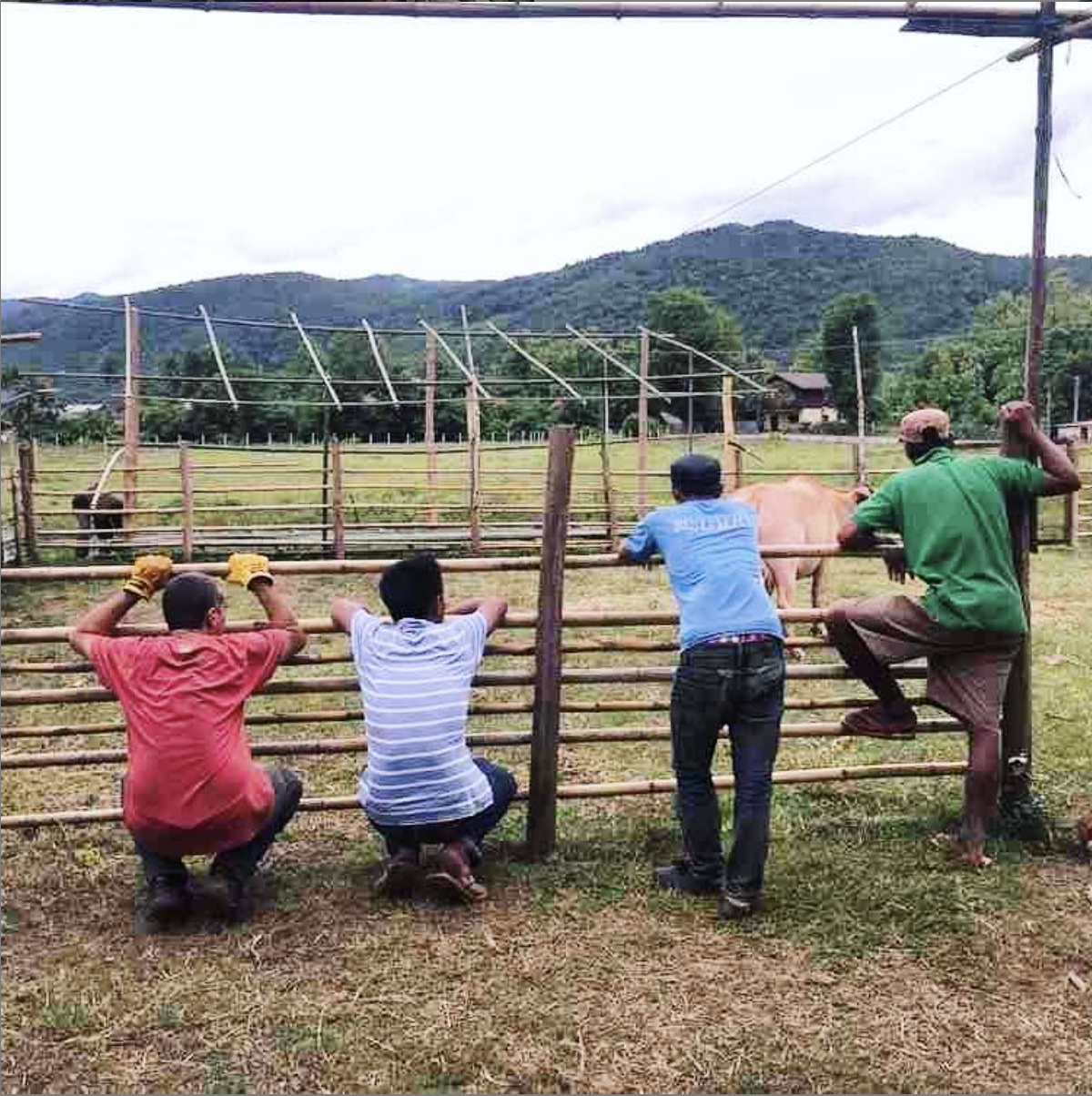
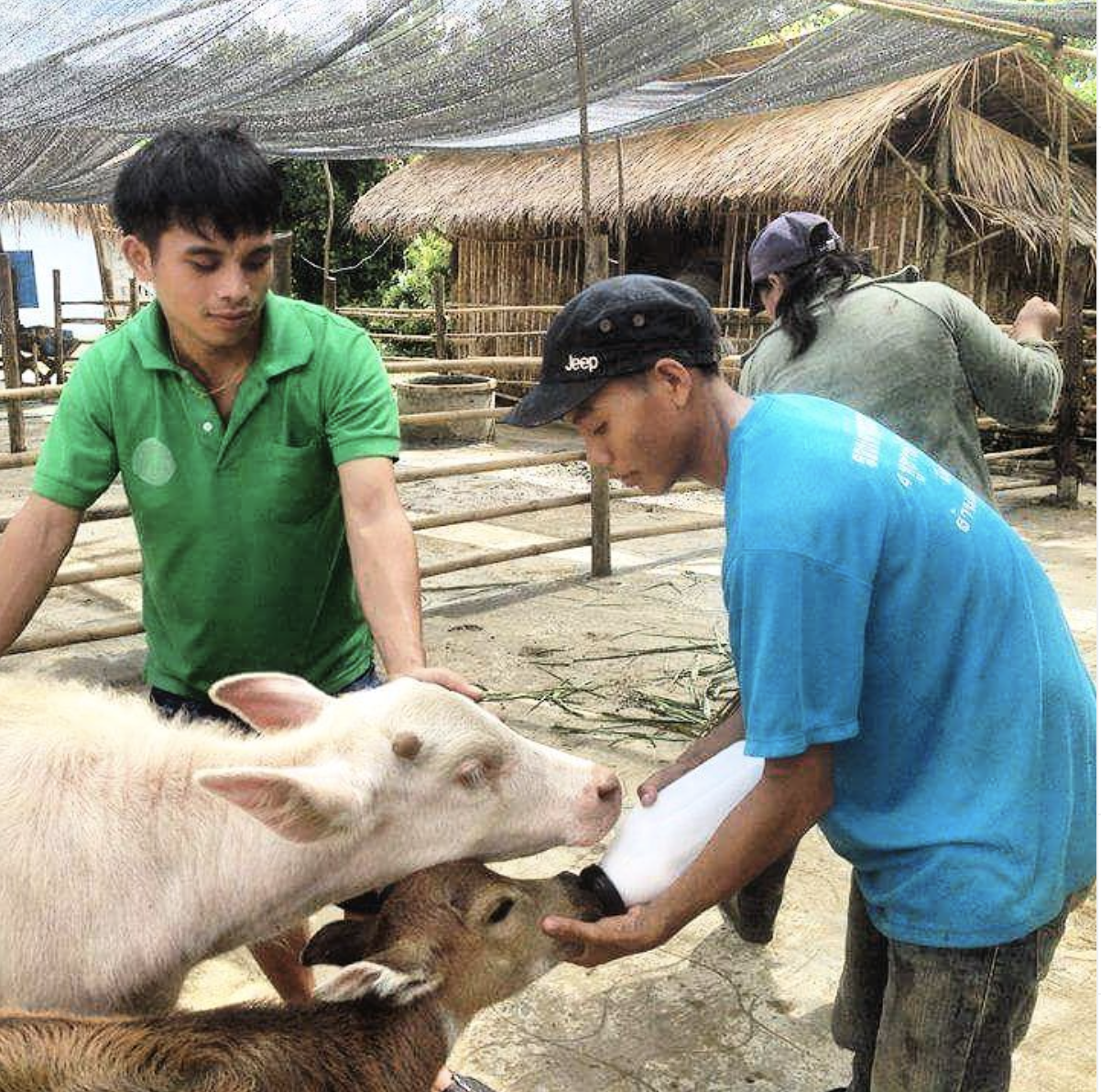
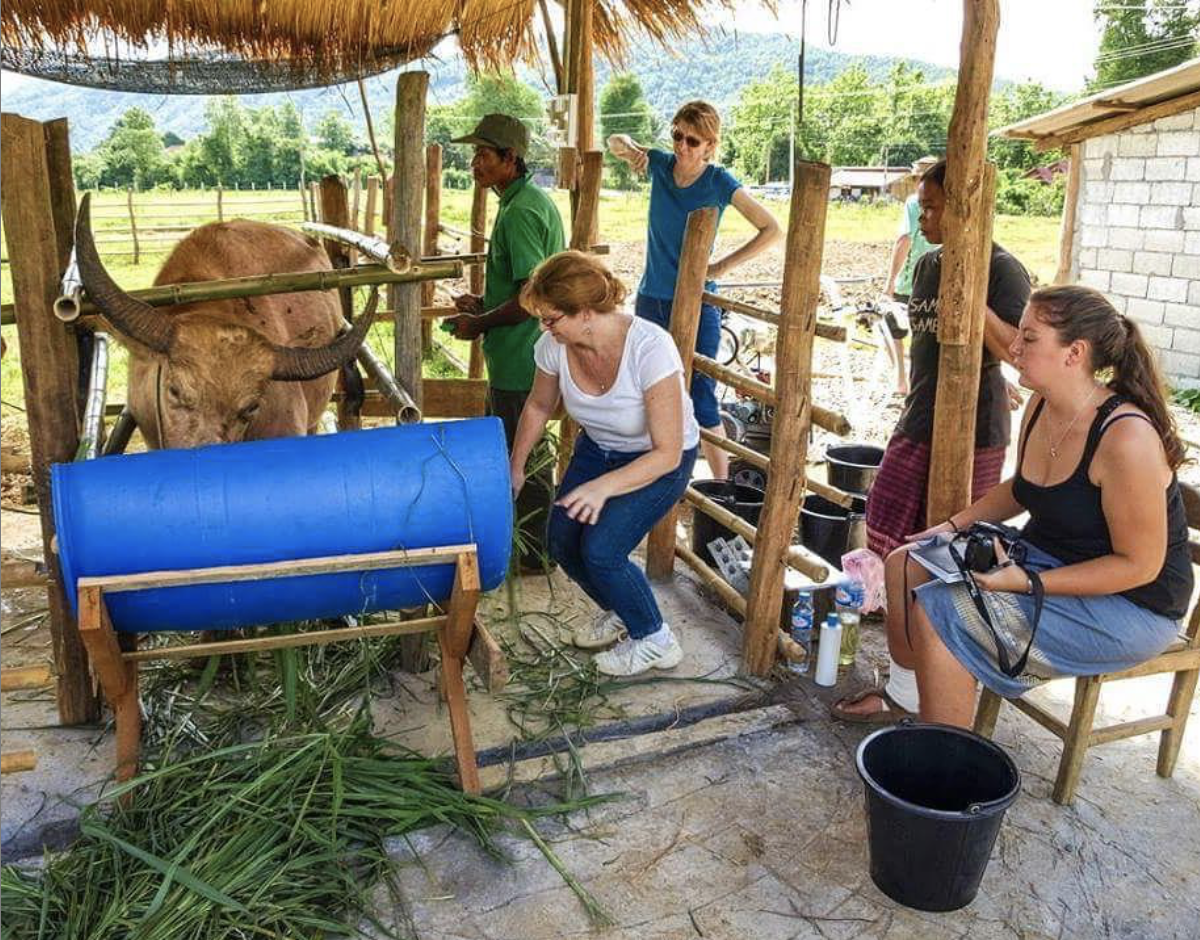
Uli and his Buffalo
A businessman in Laos, by the name of Uli had heard about what we are doing and he thought it was a great idea that would benefit the local people. He offered to buy pregnant buffalo to keep on our farm. That was a very generous offer and we were excited that he believed in what we were doing, but we needed to tell him we were not ready yet. The mini-farm was very rudimentary at this point and couldn't house that many buffalo.
He agreed to wait and we went about our business talking with people, feeding the few buffalo we already had, training a team, and just generally going about the day, trying to make things work. Then about two months later, we got a phone call from Uli – he had found a trader and bought nine pregnant buffalo and they should be arriving soon. That’s fantastic, but we still weren’t ready for them! This of course posed a problem as Uli didn’t have any land to keep the buffalo on. So, after some back and forth phone calls, he finally found a friend who was willing to take them for a temporary time until we could transfer them to the farm. This made us move faster. We needed to finish the mini-farm to take them.
But, we decided some other things needed to happen before the buffalo came to us. Like knowing if they were pregnant and how far pregnant they were. After an initial assessment, it turned out that of the nine buffalo he bought that were supposed to be pregnant, only four actually were. Uli sold the five buffalo who weren’t pregnant and we brought the other four to the farm to wait. One of these buffalo was to become our star, Lola! Thanks to Uli, we had some more buffalo to give us milk, but still not enough.
In the end, the reticence of the farmers to become involved caused us to do something drastic. In September 2017, we were still only getting about six liters of milk a day, as we only had a few buffalo on the farm. If we wanted to succeed, we needed more milk so we could make products to sell. We went to our friends at the Mini Murrah Farm just outside of Bangkok, Thailand and we arranged to buy 12 pregnant Murrah buffalo from them. On 26 September 2017, our pregnant ladies arrived on the farm. It was quite a to-do to get them off the truck too. You could tell the team was a little hesitant with these big beasts – they are much bigger than the local swamp buffalo. We tried telling them in Lao to move off the truck and then in English, but it wasn’t until a team member spoke to them in Thai that they actually moved. A good laugh was had by all, and our pregnant buffalo moved into quarantine for their first month with us. And now we had to wait for the calves to be born...
The Murrah heading to quarantine just after getting off the truck.
In our next blog, find out how our buffalo breeding program developed and meet the cute buffalo calves...
HAVE YOU SEEN OUR SOCIAL MEDIA THIS WEEK?
If not, pop on over to facebook/laosbuffalodairy or instagram/laosbuffalodairy to see what we have been up to!
TOURISM IN NEED
COVID-19 has badly affected tourism and visits to the farm. In order to mitigate some of the effects of the loss of income this has meant for the dairy, we have teamed up with the Tourism in Need initiative that supports responsible tourism organizations affected by the pandemic. Through this initiative, travelers can support the dairy through the Give Today, Go Tomorrow fundraising scheme. Click here to find out more and to make a contribution to help us to pay farmers and team members, and continue to train farmers and work on our nutrition program.
The Laos Buffalo Dairy Story: Part 1 - From Singapore to Mozzarella
In this week’s blog post chef Rachel shares our story as we tell it on the farm tour. We realise that while some people know about us, they don’t really know how we got here. Well, here goes!
In this week’s blog post chef Rachel shares our story as we tell it on the farm tour. We realise that while some people know about us, they don’t really know how we got here. Well, here goes!
Callie, Josh, Brie and Sarah on holiday in Borneo.
In 2013 our two families had a collective mid-life crisis. Susie quit her job, and a few months later, Matt quit his job. It was Halloween night in Singapore when Matt called me to say he had quit and was going to get a beer before coming home. At the time, I was walking down 42 flights of stairs with the kids and trick-or-treating. Talk about a time to have a mid-life crisis and a bit of a freak-out!
When I arrived home and told Susie what had happened, I asked her what we were going to do now, because I knew I certainly wasn’t ready to go home (meaning back to America). Susie suggested we go build a hotel somewhere and I agreed and thought we should go to Laos. Now, you might ask why a hotel and what could we possibly know about building one?? Well, Susie was regional GM of serviced offices with a head for numbers, marketing and staffing; Steven was an electrician and a construction manager in his old life; I was a chef and Matt was in finance. All four of us made a great team to start a project like this.
The next day we broke the news to Steven and Matt and told them our idea, and not even two weeks later, Susie and I were on a plane to go have a look-see at Luang Prabang. We had been to Luang Prabang to visit as tourists, but now we decided to go have a look to see if we might be able to go and move there for any opportunities and have a life there with our families.
Our buffalo curd & treacle breakfast in Sri Lanka.
While visiting, Susie and I decided to spend more money on food-related things than accommodation. One of the things we decided to do was to take the cooking class with Amantaka, a luxury hotel, and which included a field trip through the morning market with the chef. While walking through the market, we asked the chef where the buffalo curd was. Having been to Sri Lanka, and having had the curd every morning for breakfast while there, we naturally assumed that we would find it in Laos as well, considering how many buffalo walked around. He looked at us like we had three heads and asked, the what? When we explained it was a rich, creamy, thick yogurt made from buffalo milk and since there were so many buffalo, we thought they would milk them and make it. The chef stopped dead in the middle of the market and gave us a wide-eyed stare, while asking, “You can milk buffalo??”
Susie and I looked at each other and said, “Oh, we can do this!” And so, an idea was born.
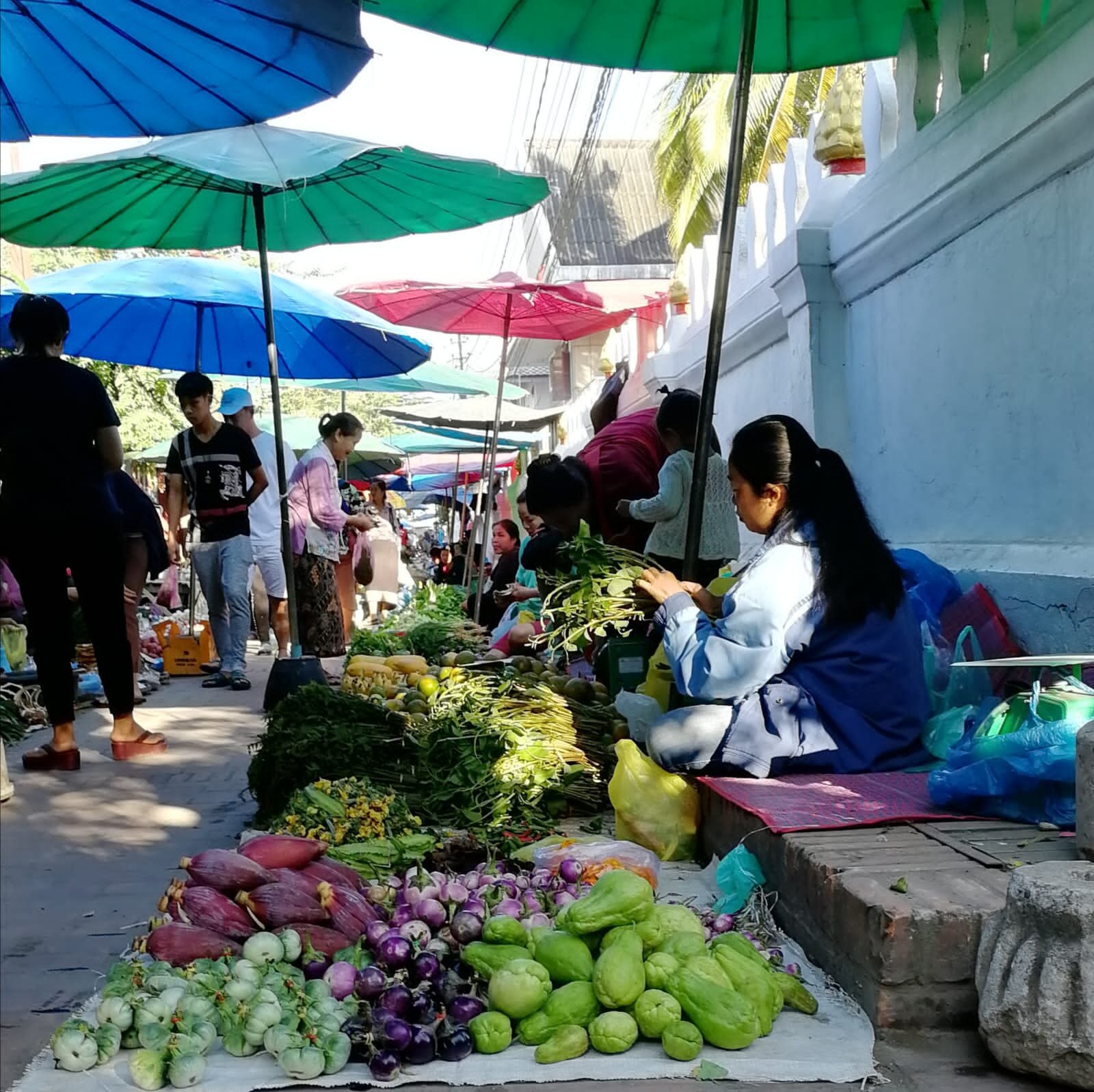
In January, the boys came back to spend ten days here. While here, Steven and Matt managed to find a guesthouse we could rent so that we could be hands-on on the ground and see how things worked. In August of 2014, Steven and Matt and the kids moved to Laos first to find houses, start running the guesthouse – Merry 1 - and get the kids settled before the school year started. In September, Susie and Rachel followed. Two days after Rachel moved to Laos, Matt moved to Hong Kong to start a new job.
When we first arrived, we had made a list of things that we thought the city could use – a real estate agency, large hotel, dairy, and some other ideas as well. Within the first few weeks we had a conversation with a friend about some of these ideas, but said that we thought the hotel should come first. The idea was always to design an eco-hotel, get the land and the licenses and then sell to the highest bidder, sit back, relax and play with the other ideas.
What a great idea! Only, it wasn’t to be that way. Two months after our arrival, our friend called us and said he had a farmer who was willing to work with us on milking buffalo. Oooooohhhhhkkkkaaaayyyyy….. so I guess that means we’re switching lanes.
Off we went to meet with this farmer and started to chat with him. We had to explain where milk came from, as it turns out that since there is no dairy culture here in Laos, most people thought that milk either came from a box (the UHT milk they are familiar with drinking) or from fruit – like coconut. We had discussions about how you could milk buffalo, just like you milk cows and showed him videos of people in India milking buffalo.
During the month and a half that we had discussions with him, we had a guest staying with us at Merry 1 that turned out to be more helpful than just a guest staying with us! One morning when she walked into reception, I looked at her and had a funny thought. I said to Maria, “Do you, by any chance, have any dairy knowledge?” Maria gave me a very shocked look and said, “Actually, yes, I do! I worked on a dairy farm for ten years, and I’ve been in dairy finance for 15!” I was so excited, I blurted out, “You’re my new best friend!”
Maria sat down at the desk with me, and I explained that we had an idea to start a buffalo dairy farm. We had a farmer that we were beginning to work with, and we needed help writing out directions on how to milk buffalo. She told me that she had never milked a buffalo, but she had milked cows and it couldn’t be all that different. After some discussion on how to do it, she promised that she would write up instructions in a step by step list for us, that we could then go and get translated into Lao. She was also interested in meeting the buffalo, as one of the things that she warned us about, was that if the buffalo were anything like cows, they weren’t very friendly with strangers and what we wanted to do might be very difficult.
With the translation done, we called the farmer again to go and see him and do some more explaining. This time he asked if we wanted to meet the buffalo. And of course, we said yes! We asked Maria if she would be interested in coming along since she was our milking specialist at this point and could be there to help answer any other questions the farmer might have as well. She was excited to come with us and meet the buffalo to gain a better idea of whether what we wanted to do would even work.
When we arrived, the farmer walked us into a little field he had nearby where he and his neighbor kept their buffalo. He told us that he had one tied to a tree as this one was kind of testy and didn’t like anyone, so he wanted to make sure we were all safe. Let me tell you it was a bit intimidating walking into that field with those big animals, having never been up close and personal with a buffalo before!
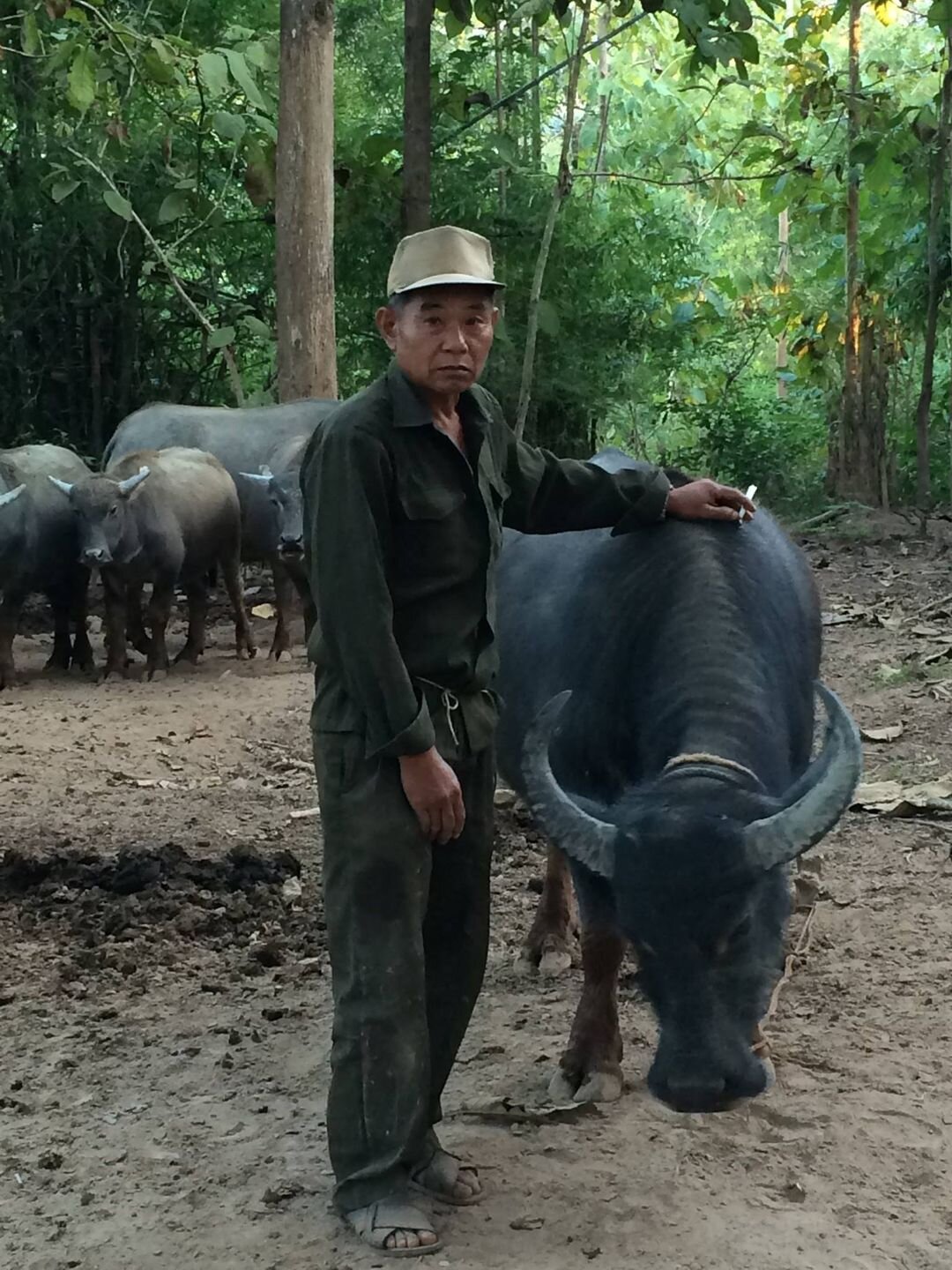


As soon as we entered, the farmer walked right up to one and started to scratch it on the butt. Its tail raised immediately, which we soon learned was a sign that it was enjoying what the farmer was doing. Before long, surrounded by curious buffalo, I was getting a bath by buffalo tongues! When the farmer noticed this, he asked if I wanted to stay with the buffalo as it was clear they liked me. Thank you, but no thank you. ☺ Maria was surprised at the curiosity and calm nature of the buffalo and decided that we wouldn’t have a problem at all if most buffalo were like this.
At the end of the day, we were happy and thought we could start a successful trial….. Until…. We received a phone call from the farmer, and he asked if the baby still needed to be drinking milk from the mother for this all to work. When we answered that yes, that was key to the trial, he told us that that had stopped a month ago. We thanked him and said we would see him next time around when the babies are born.
Being stalked by a buffalo…..but isn’t she cute???
At this point, we decided that we had invested quite a bit of time into what we were trying to achieve and that it was worth sending our team members out on a search to find another farmer who might be interested in working with us. It took about six more months, but finally, we came across Somlit, the village chief in Ban Thinkeo. Somlit is an outside the box kind of guy, and we love him! We spoke with him a few times and explained what it was that we wanted to do. We sat with him and some of his villagers to describe the milking and why it would be good. After some discussions, Somlit told us he would find us a farmer with who we could work.
Finally, we sat down with Mr. Eh, one of the villagers, who had three buffalo with calves that ranged in age from 2.5 – 4.5 months. We talked about the 6-week trial we’d like to do. We explained that we would need to build a fence with a separate pen for the calves and that while they were penned and separated, he would need to feed and water them. This approach was a big deal as in Laos, farmers generally cannot afford to feed, vaccinate, or pen in their animals, so they allow them to roam free looking for food and often wandering in areas where there may be diseases that could harm them.
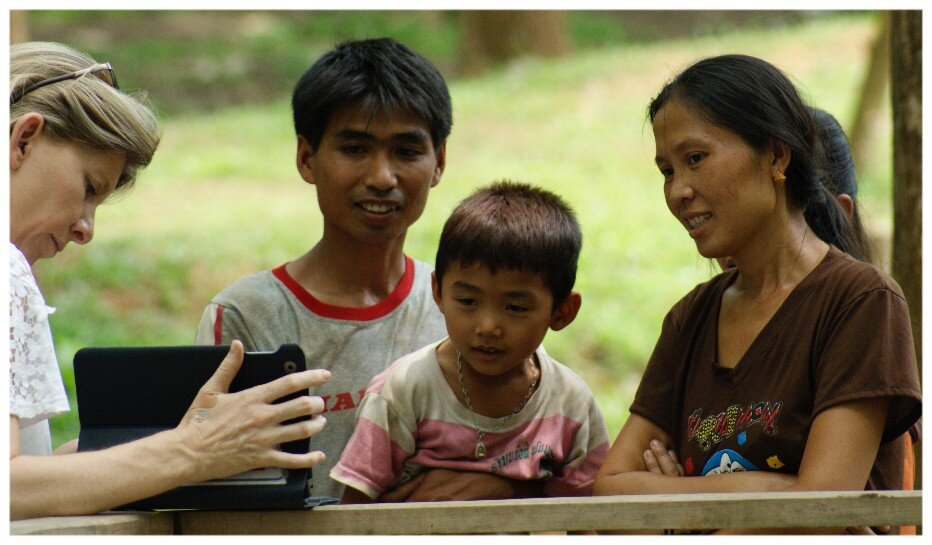

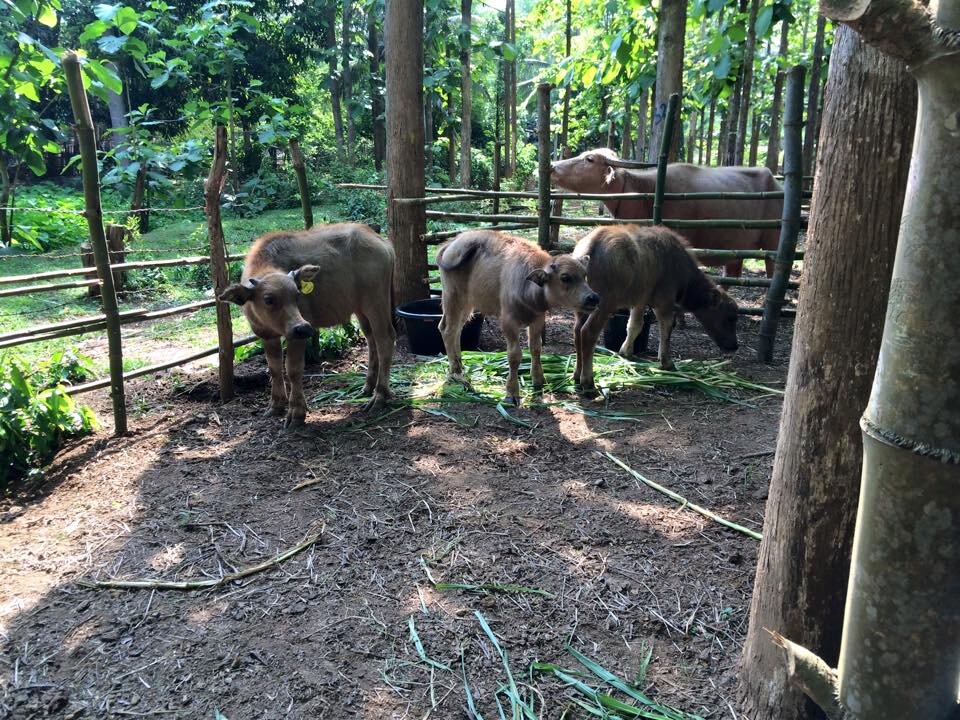
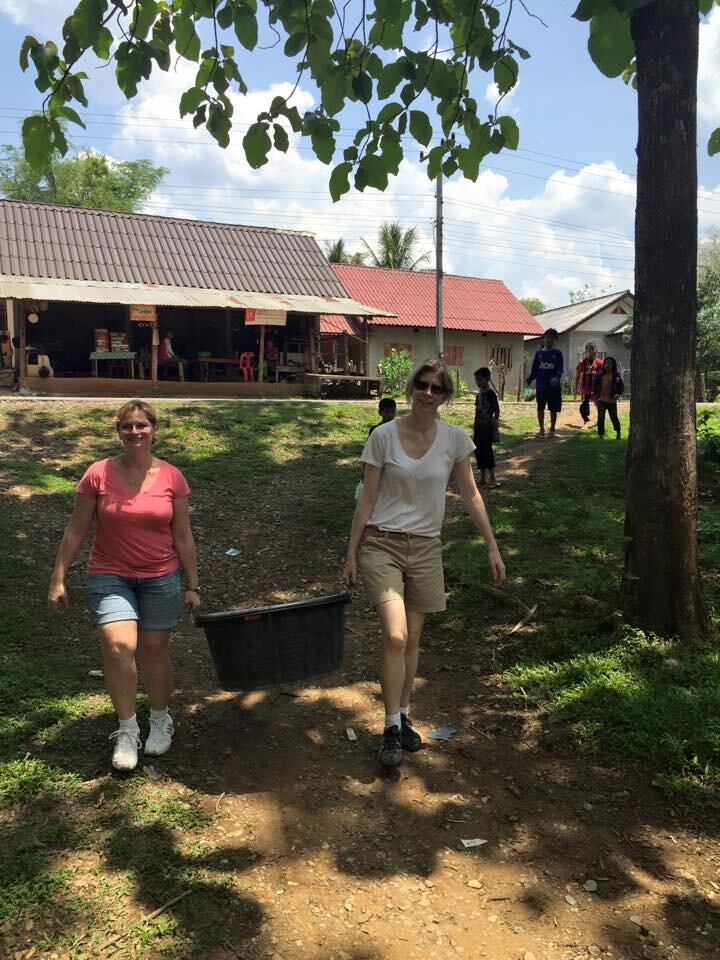
We looked at an area he had under some teak trees where he already had a pen of sorts built and then discussed how it would need to be changed a bit and reinforced. And add in a crush that we will be able to get the buffalo into securely so we can milk her. We explained that she would be more amenable to milking if we fed her at the same time and we would need to build a little trough as well. We bought the supplies to do it all and like Captain Picard, on Star Trek instructed, “Make it so!”
Once the buffalo were penned and separated, we started to milk or at least tried to milk them. It took a bit of time for them to get used to what we are doing and produce any milk. Having never been handled like this, we needed to teach Mr. Eh and his wife how to do it, since it was their buffalo and they were more accustomed to being handled by them. We were very excited when it worked. We had already talked with Mr. Eh about how the milk needed to be kept cold after milking until we could pick it up. And this posed a problem in the beginning as most people in Laos still do not have refrigeration in their homes, but they do have big coolers that they fill with ice. We supplied him with containers to milk into and store the milk – a separate one for each buffalo so we could keep track of how much milk they gave.
Steven as the “Caped Cheese Crusader” flying by to go get milk.
Steven drove out to Thinkeo every day to collect the milk and bring it home to me. Every 3 to 4 days, I had enough milk with which to experiment. And every 3 to 4 days, I tried to make cheese and cried. Why did I cry? Well, it was impossible to find cheese recipes online for making buffalo milk cheeses. There were very few people out there who made buffalo milk cheese and those who did, did not usually share their recipes. So, having never made cheese before, I was using a cow’s milk recipe to try and make it work for buffalo milk and adjusting after each new batch to try for a successful trial. Only, the composition of cow’s milk and buffalo milk are very different and do not react the same way with the ingredients, hence the tears.
I finally decided after days (more like weeks!) of crying and failing, that I needed help! I looked online and found all of the dairies worldwide who made buffalo milk mozzarella and emailed them all with my plight. Of the 15 dairies that I emailed, only one replied. And that was Thea from Shaw River Dairy in Australia who emailed and offered help. In her email, she told me that she could give me her recipe but that it won’t work, which of course stops me right there and I burst into tears yet again! But as I read on, she explained that the differences in fat in the milk plays with the ingredients, and I would have to adjust accordingly. I had an “aha!” moment and realised that I could work with this. So, I compared the recipes, with where I had started, where I have gotten to and with what Thea gave me, and I tried her recipe first. She was right, it didn’t work, but it did get me a lot closer. With a bit more adjusting, I finally perfect a mozzarella ball, just as we finish our 6-week trial. But, at least now we know that we can get milk from the local swamp buffalo and that I can successfully make mozzarella!
Next time...Building Laos' first ever dairy in Luang Prabang!
Here at Laos Buffalo Dairy, we are proud to be recognised at the prestigious WTM World Responsible Tourism Award in the Neighbours and Employees category. The awards this year were a little different as the judges decided to commend businesses and destinations which are taking responsibility and addressing the many challenges of Covid-19.
We won the award for the work we are doing to support the local Laos communities in and around Luang Prabang by setting up the first Buffalo Dairy in the country. The dairy is a popular and growing tourism attraction, and when Covid-19 hit all the income from tourists went away. Instead of shutting up shop, we re-imagined how we could continue to support our staff and the local communities.
Below is what we have been doing to keep local people employed and how we have been using our facilities to help our neighbours cope with Covid-19.
Staff
The dairy continues to employ all its regular staff, all of whom come from the local villages and, although payments have been reduced, all staff still make over the minimum wage. Also, free housing has remained available to any staff if needed. Free English classes for staff continue, meaning the chance to upskill for when Covid-19 is over. For any of the team with children, there is free buffalo milk to improve family nutrition.
Community
In the wider community, we have continued with the nutrition programme we have been implementing. The programme involves pilot projects in four local villages to research the best ways to increase nutrition, and implement improvements with resources already available to villagers. Issues with nutritional concerns will not go away with Covid-19, so continuing to work out the best practice in this area will allow us to roll out the programme on schedule, after reviewing the pilot stage.
Also, as part of the nutrition programme, we continue to expand and diversify from being solely a buffalo farm. During Covid-19 the first two cows arrived at the farm, and recently we acquired our first goats as part of our project to create a goat haven. All of these actions continue to help support the local rural village communities in a time of need.
Instead of cutting back training, the dairy is also continuing a farmer training programme to help the local villages.
Initially, we supported 17 villages and increased this to 20+ communities, all of which continue to receive support during Covid-19.
Free English classes take place on-site, and between 30-50 local children attend these elementary classes. Besides this, during the school holidays, the dairy teamed up with other responsible tourism organisations (Traditional Arts and Ethnology Centre, MandaLao Elephants and Free the Bears) to create a week-long English Language Summer School programme. The scheme allowed around 30 children from the local villages to attend English lessons, and visit these local tourist attractions.
The dairy has built a children’s play area that the local children can come and use every day (Monday-Friday). Up to 20 children use this facility each day.
To increase domestic tourism, we refocused on the local market, and for 50,000 Laos Kip ($6) we offer a tour of the buffalo farm. The money paid can also be used against any purchases in the cafe and is sufficient to cover three scoops of ice cream per person.
All of these programmes could have stopped due to Covid-19. However, it is a sign of the spirit, determination and commitment to our vision that we found a way to continue helping the local communities and loyal staff.
Coming soon!!!
The Little Book Co
We've got exciting news! We've been invited to have a page in a new coffee table book featuring inspiring stories of female business owners and change makers!
The book is going through pre production now and should be available by mid November. Keep your eyes on our next newsletter for more information!
HAVE YOU SEEN OUR SOCIAL MEDIA THIS WEEK?
If not, pop on over to facebook/laosbuffalodairy or instagram/laosbuffalodairy to see what we have been up to!
Lights, camera, action
The phone rings and Lathsavong, Dairy Manager announces that the government would like to come and visit the Dairy tomorrow. In Laos there can be a fair amount of government bureaucracy to satisfy with any business let alone a new industry, so not quite understanding the harassed quality to Lathsavong voice I ask what time they’re due to arrive, thankfully it’s tomorrow afternoon. We have the career fair at the Northern College of Agriculture starting at 8 am tomorrow but if we leave at lunchtime we should be able to make it the 90 mins over to the farm in time for their arrival. So unconcerned am I, that Steven, the Dairy General Manager is having a well earnt day off the next day and asks if he should attend. No, No that won’t be necessary!
The phone rings and Lathsavong, Dairy Manager announces that the government would like to come and visit the Dairy tomorrow. In Laos there can be a fair amount of government bureaucracy to satisfy with any business let alone a new industry, so not quite understanding the harassed quality to Lathsavong voice I ask what time they’re due to arrive, thankfully it’s tomorrow afternoon. We have the career fair at the Northern College of Agriculture starting at 8 am tomorrow but if we leave at lunchtime we should be able to make it the 90 mins over to the farm in time for their arrival. So unconcerned am I, that Steven, the Dairy General Manager is having a well earnt day off the next day and asks if he should attend. No, No that won’t be necessary!
The career fair goes well (see Mobbed by the Crowd) and we start our journey across town with a quick stop off to pick up more yogurt and cheesecake having been cleared out at the career fair. Arrive 90 mins later, set up a table with some information on the Dairy and some product ready to go. The night before had seen torrential rain so whilst waiting for government we decide to help clear out the storeroom which had seen some water get in and unable to help myself, I proceed to re-arrange it. We have printed out signs in English & Laos to keep everything in its proper place, so that my mild case of OCD is satisfied. Job done, we now wait to see what time our visitors will arrive.
A few minutes later we hear cars approaching along the road and a convoy of cars complete with police escort passes the gates. We go to sit down again, however as we go to turn I notice the police escort do a U-Turn followed by the rest of the convoy, I say to Jennifer I think they may be coming back to us. Jennifer laughs no it couldn’t be ohhh it is, they are turning into the gate. A definite pregnant pause as we all look at one another with a “What do we do now?” expression across all of our faces.
At this moment all I can think is: thank goodness we had the career fair earlier in the morning so I am wearing my “Sin” traditional Laos skirt and good shirt as opposed to my usual wardrobe of jeans and t-shirt.
I, Lathsavong & Lam all line up – think receiving line at an event with the Queen or equivalent! The rest of the team all looking slightly nonplussed pause in whatever they are doing to see what they should do next. Very good question as we’re not quite what sure to expect at this point either.
The cars have now driven up our very muddy road and begin to disgorge their guests. We have the official staff of the Lao National Council, Livestock & Fisheries department, Luang Prabang Agriculture and Forestry; the Chief of Luang Prabang Livestock and Fisheries, Mr. Kanchan and then our guest of honour Deputy Director Lao National Council, Mr. Sounthone. Greetings alone take a good 5 minutes particularly as none of us are really very sure on the protocol of greeting this many people from the government!
The only “meeting spot” we have is a low table with tiny stools that the staff use when having lunch. Greetings over, we gather around the table, some on stools, some sitting on the railings and some standing, it’s quite a crowd! Lathsavong begins with a formal introduction of himself, me and the rest of the team, this could take quite a while! It then moves on to a laptop presentation with me holding the laptop so everyone can see. The noisiest things by far are the chickens who have decided that running around between everyone’s legs and under the tables is great sport – definitely going to be chicken soup at this rate!
Then proceedings pick up pace and it’s a whirl of activity as we head towards the milking area. Many questions and quite a few jokes ensue as we discuss milking and udders. The word for milk and breast are the same in Laos, so quite a few guffaws all around as our husband and wife team Boon Soon and Saw step us to begin the milking with Boon Soon being asked about touching boobs with his wife in the vicinity.
Next comes feeding our baby calves. The cuteness factor never fails and we soon have everyone jostling for a turn to hold the bottles. Then it’s on to taste testing the yogurt and cheesecake.
A few days later, there was another call from Lathsavong. Being “old pro’s” now we spring into action and have everything ready and everyone lined up for our next visitors. Dr. Bounkhuang KHAMBOUNHEUNG, the deputy minister of Ministry of Agriculture and Forestry of Luang Prabang province is our guest of honour today and have to admit it never gets old when your visitor has a police escort! He is also companied by various staff from the ministry and today not only do we have photographers we have TV. Sure enough after this visit we appear on the Laos News channel. One of our friends even took a photo of his TV screen to show us!
There is however a serious side and the government from both visits are very keen to understand more about the dairy and how everything works; the involvement of the farmers buffalo, how we will look after the buffalo and most importantly are very keen to know how they can help. It’s becoming apparent that they see our business as the beginning of a sustainable industry filling a real need in the market for dairy products that will also assist the local farmers through additional income, conserve buffalo and provide another attraction for tourists along the Kuang Si Waterfall road thus extending their time in Luang Prabang and helping to increase the average spend of tourists in the city.
























